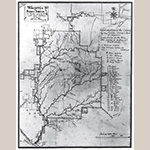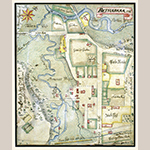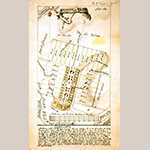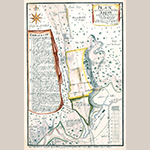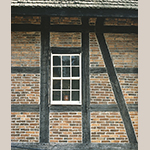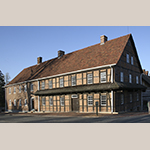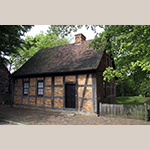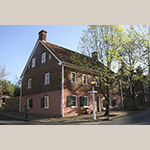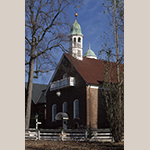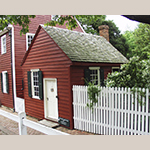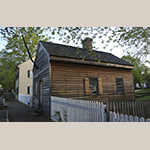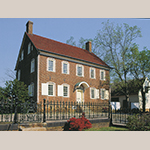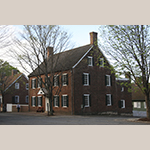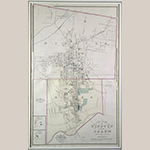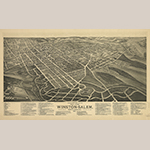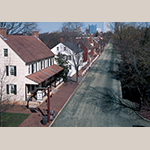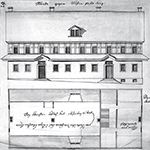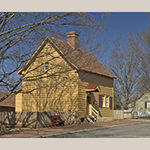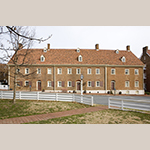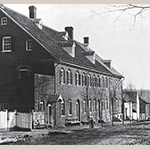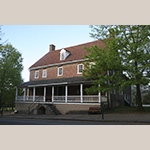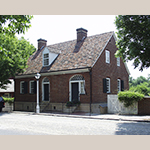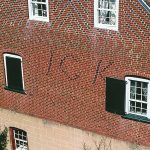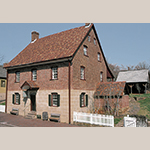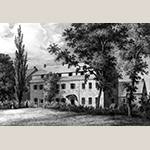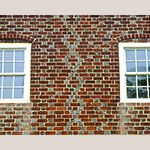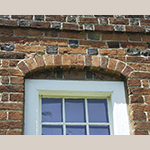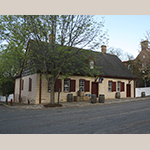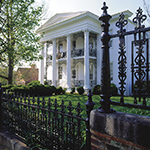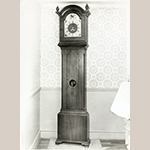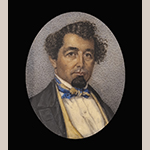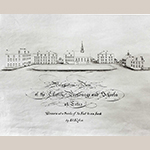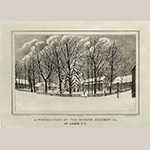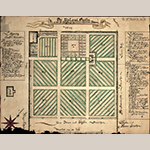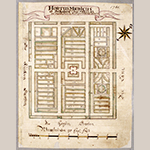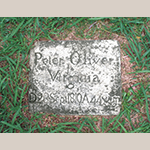
The Moravian town of Salem serves as a microcosm of the American architectural experience. From its roots in the Old World Germanic style to the early American period designs, Salem’s architecture is as varied as the people who contributed to its built landscape. Celebrating the 250th anniversary of the founding of Salem, this article presents biographical sketches of many of the talented and industrious craftsmen who created the town out of the wilderness and continued to shape its architectural legacy well into the nineteenth century.The sixty-five biographies included here are of men—black and white; free and enslaved—who could be determined through the historical record to have left a lasting mark on the buildings of Salem.[1]
Click Here to Browse Salem Craftsmen Alphabetically by Name
Click Here to Browse Salem Craftsmen by Trade
Introduction to Salem and the Moravians
The Unity of Brethren—better known in English-speaking regions as “Moravians” for their origins in the central European land of Moravia (now part of the Czech Republic)—is a Protestant denomination that traces its origins to the fifteenth-century martyr John Hus. After centuries of persecution, in the early eighteenth century the Moravians were able to find a sponsor and home in Herrnhut, Germany on the estate of Count Nicholas von Zinzendorf. Under Zinzendorf’s leadership, the Moravians greatly expanded their missionary activities outward from Herrnhut across Europe, the British Isles and into the New World.
In these new communities the Moravians could freely follow their communal, pacifist, and religion-centered way of life and carry the gospel to potential converts. The church strictly controlled both the spiritual and secular matters in its communities. Several committee boards in each town oversaw and kept extensive records of its congregation’s activities, including religious affairs, marriages, education, occupations, business operations, and communal needs such as roads, water, and community buildings. Of most importance to the building trades was the Aufseher Collegium (board of supervisors) that oversaw the financial and material business of the town.
At the core of Moravian congregations were the choirs, or groups bonded by age, gender, or marital status. Members of each choir came together, and sometimes lived together, for spiritual growth as well as sharing responsibilities of life within the church and town. Choirs included the Single Brothers, Single Sisters, Married Brothers, Married Sisters, Widowers, Widows, Older Boys, Older Girls, Little Boys, Little Girls, and Infants.
In 1753 the Moravians purchased approximately 100,000 acres of land in Piedmont North Carolina from the colony’s proprietor, John Carteret, the Earl of Granville. They named this tract Wachau after the location of Count Zinzendorf’s ancestral estate along the Danube River in the Wachau Valley of Austria. Later the name was Latinized to “Wachovia.” The Wachovia Tract is the site of present-day Winston-Salem and much of Forsyth County, North Carolina (Figure 1).
Church leaders in the Moravian town of Bethlehem, Pennsylvania nearly immediately began sending settlers to establish communities in the Wachovia Tract. The first town was Bethabara followed by Bethania, established in 1759 (Figures 2 and 3). A central trade and administrative town in Wachovia, to be named Salem, had been planned from the very beginning, but the French and Indian War (1754–1763) greatly disrupted and delayed actual site preparation and construction.
In 1763 Frederick William Marshall was named chief administrator of Wachovia, arriving in Bethabara the following year. He stated his mandate succinctly by announcing that the “founding of a new town in Wachovia was the chief object of his visit.” The next months were spent inspecting various sites until a final selection was made on 14 February 1765. With his objective completed, Marshall left Wachovia a week later and returned to Pennsylvania and then sailed for Europe. In his place, Marshall appointed Johannes Ettwein in charge of preparing to develop the new town of Salem.
Eight men relocated from Bethabara to the site of Salem in February 1766 to begin construction. They were George Holder, Niels Petersen, Jens Schmidt, Gottfried Praetzel, John Birkhead, Jacob Steiner, Melchior Rasp, and Michael Ziegler. In two wagons they brought brick and tile for roofing. Following Old World traditions, whenever possible the Moravians employed clay tiles made by a potter to roof their principal buildings. Many of other essential materials were prepared in Bethabara’s workshops and sent to Salem.
Although he was absent from Wachovia, Marshall clearly articulated his vision for the town of Salem in his correspondence to Ettwein. In a July 1765 letter sent from Bethlehem, Marshall covered the spectrum from the broadest philosophical purpose of the town down to its smallest details. He explained, “This town is not designed for farmers but for those with trades.” The purpose of Salem, he wrote, was to be:
more like a family where the religious and material condition of each person is known in detail, where each person receives the appropriate choir oversight, and also assistance in consecrating the daily life. This must be considered in deciding the form of the town plan.
For Salem, Marshall drew extensively from the example of Lititz, Pennsylvania, developed by Moravian surveyor Christian Gottlieb Reuter, which had a standard lot size of sixty-six by four hundred feet and street widths of sixty feet for the main street and forty feet for others, all arranged on a grid pattern (Figure 4). Around a central square he proposed the major congregational buildings. With an eye for the overall appearance of Salem, Marshall suggested “to keep the plan symmetrical the store might be placed on the lower corner [of the square] since it is larger than a family house.”[2]
In February 1768, Marshall returned to Wachovia to personally “undertake to have houses built for the Single Brethren and for the Single Sisters in Salem as soon as possible… and arrange all things in Salem according to the custom of our Congregation and Choirs in Europe.”
In 1772 the initial construction phase of Salem was completed and the administration of Wachovia moved from Bethabara to Salem, which was also ready for the first permanent residents. The first generation of buildings in Salem, constructed by European-trained artisans such as Melchior Rasp, incorporated Germanic traditions adapted to the local setting and relied chiefly on stone, log, and half-timber (Fachwerk) construction (Figure 5). The use of half-timbering was particularly driven by the difficulty the Moravians found in consistently procuring lime for a strong mortar. Salem’s early masons resorted to using a clay-based mortar that was not stable enough to use in solid brick walls and used half-timbering. Salem’s Single Brothers’ House (Figure 6) and the Fourth House (Figure 7) are half-timbered examples that still stand, restored to their eighteenth-century appearance.
Salem, like many American communities after the Revolutionary War, engaged in a major building campaign. Projects that had been postponed because of the war now took priority. Improved local procurement of lime mortar allowed for solid brick construction of major buildings rather than half-timbering. Old World building traditions in Salem dissipated with the passing of the town’s European-trained craftsmen and the rising influence of those born and trained in America such as Johann Gottlob Krause and Frederick Edward Belo as well as the non-Moravian William Craig.
Aware of these changes in the face of a building boom, Frederick William Marshall prepared a set of “Building Rules” that were enacted in June 1788. More than any other document, the “Building Rules” showed Marshall’s concern for community planning as integrated with both spiritual and secular well-being. The document covers all aspects of the built environment and shows Marshall’s deep understanding of architecture, building trades, and town planning.
Marshall continued to shape the architecture of Salem into the last decade of the eighteenth century. In 1794 he supervised the design of the Salem Boys’ School (Figure 8). In April 1797 Marshall undertook his crowning architectural achievement, Home Moravian Church (Figure 9). The imposing brick building combines fine Flemish bond brickwork and a traditional Moravian plastered cornice with tall, arched windows and other motifs reflective of the nationally and internationally prevalent taste for neoclassicism. In this building, Marshall introduced an apparently original entrance treatment: an arched hood that became a distinctive and lasting feature of Salem architecture and was revived early in the twentieth century as part of a local Moravian or Salem Revival style.
The Moravian town of Salem would undergo profound changes in the nineteenth century as the church was gradually compelled to loosen control over the daily life of the congregation. A growing American individuality was taking root among Salem’s citizens and conflict with the Moravian theocracy was inevitable. This dynamic emerged architecturally in the form of small workshops built near private houses where Salem’s craftsmen plied their trade rather than in the communal Single Brothers’ House. Examples of this trend include the Schultz House and Shop (Figure 10) and Timothy Vogler House and Shop (Figure 11). Stylistically, rather than harkening back to European traditions, Salem’s builders continued to embrace broader national tastes in features such as Flemish bond brickwork, end chimneys, and central hall plans seen on statement structures like the Vierling House (Figure 12) and John Vogler House (Figure 13).
During the 1830s, advances in technologies and a cotton boom in the South expanded Moravian businesses to dramatic new heights. Factories making wagons and textile mills brought not only immense wealth but also outside investors and ideals. In 1849 the state of North Carolina created Forsyth County with Salem intended to be the site of the county courthouse. Salem’s church administrators successfully resisted the plan by selling approximately fifty acres of land just north of Salem for a new town to be named Winston that would serve as the county seat (Figure 14).
The tensions between sacred and secular in Salem finally came to a head in 1856 when the church council voted to abolish the lease system that had prohibited residents who were not members of the Moravian congregation from owning property in the town and conducting businesses as individuals. This marked the end of the Moravian Church’s governance of the town of Salem as a theocracy. In December 1856 the town officially became an incorporated municipality and elections were held for mayor and eight town commissioners.
The towns of Salem and Winston co-existed through the American Civil War but Reconstruction brought an end to the growth and prosperity that Salem enjoyed for much of the nineteenth century. In contrast, Winston’s tobacco and textiles industries, led by the Reynolds and Hanes families, grew into national empires. In 1913 the two towns were officially consolidated to form the city of Winston-Salem (Figure 15).
The historic buildings and streetscapes of Salem were in serious decline by the 1940s and threatened by obliteration through urban growth. A group of concerned citizens came together in 1947 to study the feasibility of preserving the town’s most important structures. Old Salem was established in 1950 to preserve or restore the historic town of Salem. Through Old Salem’s efforts, the immense talent and effort of the many individuals that created Salem’s built landscape can be experienced and appreciated 250 years after the first tradesman began carving a town out of the wilderness (Figure 16).
Index of Craftsmen by Trade
(presented chronologically by working dates)
|
Melchior Rasp – worked 1755–1784 Abraham Gottlieb Steiner – worked 1758–unknown Christian Renetus Heckewilder – worked 1766–ca. 1774 Johann Samuel Mau – worked 1766–1774 William Gentry – worked 1770–1772 Johann Gottlob Krause – worked 1771–1802 Johann Heinrich Blum – worked 1773–1824 Melchior Fischer – worked 1774–1794 George Fischer – worked 1780–1810 Abraham Hauser – worked 1782–1797 Abraham Loesch – worked 1782–circa 1820 Johann Michael Seiz Jr. – worked 1784-1788 William Volk – worked 1784–unknown William Craig – worked 1794–circa 1820 John David Blum – worked 1802–1842 William Hauser – worked 1802– unknown Pleasant Roberts – worked ca. 1803 |
George Holder – worked 1754–1768 Jacob Steiner – worked 1755-1777 Christian Triebel – worked 1755–1788 Rudolf Strehle – worked 1764-1790 Niels Petersen – worked 1766-1774 David Holzapfel – worked 1770-1856 Melchior Fischer – worked 1726-1798 Martin Lick – worked ca. 1777-1789 Johann Michael Seiz Jr. – worked 1784-1788 Jacob Spach – worked ca. 1786-1856 Charles Alexander Cooper – worked 1831-ca. 1850
|
|
John Jacob Wohlfarth – worked 1769–1807 Andreas Brosing – worked 1770-1781 George Fischer – worked 1780-1810 Neman van Zevely – worked 1797-1809 Thomas Holland – worked 1802–unknown Magnus Benjamin Hulthin – worked 1805–ca. 1813 Johann Friedrich Belo – worked 1806–1827 Karsten Petersen – worked 1806-1857 Daniel Wohlfarth – worked 1806–ca.1820 Johann Thomas Wohlfarth – worked 1808–1830 Daniel Wolf – worked 1811–1830 Charles Abraham Steiner – worked 1811-1879 Johann Heinrich Keller – worked 1816-1818 Frederick Edward Belo – worked 1827- ca. 1843 George Mumford Swink – worked 1839-1852 |
Johann George Ebert – worked 1794-1796 Johann Simon Leicht – worked 1805-1812 Peter Fetter – worked 1827–1847 |
|
Frederick William Marshall – worked 1764-1802 Elias Alexander Vogler – worked 1846-1876 |
Christian Gottlieb Reuter – worked 1758-1777 Carl Ludwig Meinung – worked 1772-ca. 1805 Frederick Christian Meinung – worked 1796-1851 |
|
Johann Christoph Schmidt – worked 1755-1799 Peter Stotz – worked 1762-1771 Charles Culver – worked 1766-1767 Cornelius Sale – worked 1776-1788 James Reuben Fletcher – worked 1782 Joseph Essig – worked 1797-1812 |
Naeman Benjamin Reich – worked 1840-1846 |
|
Christian (formerly Frank) – worked 1771-1789 Abraham (formerly Sambo) – worked 1771-1797 Sam – worked 1775-ca. 1790 Champion – worked ca. 1783 Peter Oliver (formerly Oliver) – worked 1784-1809 George – worked ca. 1785 |
Erich Ingbretsen – worked 1753-1759 Lorenz Bagge – worked 1764-1783 John Birkhead – worked 1766-1771 Jens Schmidt – worked 1766-1768 |
Index of Craftsmen by Name
(presented alphabetically)
|
Abraham (formerly Sambo) – worked 1771-1797 Bagge, Lorenz – worked 1764-1783 Belo, Frederick Edward – worked 1827– ca. 1843 Belo, Johann Friedrich – worked 1806–1827 Birkhead, John – worked 1766-1771 Blum, Johann Heinrich – worked 1773–1824 Blum, John David – worked 1802–1842 Browsing, Andreas – worked 1770-1781 Champion – worked ca. 1783 Christian (formerly Frank) – worked 1771-1789 Cooper, Charles Alexander – worked 1831-ca. 1850 Craig, William – worked 1794–circa 1820 Culver, Charles – worked 1766-1767 Ebert, Johann George – worked 1794-1796 Essig, Joseph – worked 1797-1812 Fetter, Peter – worked 1827–1847 Fischer, George – worked 1780-1810 Fischer, Melchior – worked 1774–1794 Fletcher, James Reuben – worked 1782 Gentry, William – worked 1770–1772 George – worked ca. 1785 Hauser, Abraham – worked 1782–1797 Hauser, William – worked 1802– unknown Heckewilder, Christian Renetus – worked 1766–ca. 1774 Holder, George – worked 1754–1768 Ingbretsen, Erich – worked 1753-1759 Holland, Thomas – worked 1802–unknown Holzapfel, David – worked 1770-1856 Hulthin, Magnus Benjamin – worked 1805-ca. 1813 Keller, Johann Heinrich – worked 1816-1818 Krause, Johann Gottlob – worked 1771–1802 Leicht, Johann Simon – worked 1805-1812 Lick, Martin – worked ca. 1777-1789 |
Loesch, Abraham – worked 1782–circa 1820 Marshall, Frederick William – worked 1764-1802 Mau, Johann Samuel – worked 1766–1774 Meinung, Carl Ludwig – worked 1772-ca. 1805 Meinung, Frederick Christian – worked 1796-1851 Oliver, Peter (formerly Oliver) – worked 1784-1809 Petersen, Karsten – worked 1806-1857 Petersen, Niels – worked 1766-1774 Rasp, Melchior – worked 1755–1784 Reich, Naeman Benjamin – worked 1840-1846 Reuter, Christian Gottlieb – worked 1758-1777 Roberts, Pleasant – worked ca. 1803 Sale, Cornelius – worked 1776-1788 Sam – worked 1775-ca. 1790 Schmidt, Jens – worked 1766-1768 Schmidt, Johann Christoph – worked 1755-1799 Seiz, Johann Michael Jr. – worked 1784-1788 Spach, Jacob – worked ca. 1786-1856 Steiner, Abraham Gottlieb – worked 1758–unknown Steiner, Charles Abraham – worked 1811-1879 Steiner, Jacob – worked 1755-1777 Stotz, Peter – worked 1762-1771 Strehle, Rudolf – worked 1764-1790 Swink, George Mumford – worked 1839-1852 Triebel, Christian – worked 1755–1788 Vogler, Elias Alexander – worked 1846-1876 Volk, William – worked 1784–unknown Wohlfarth, Daniel – worked 1806–ca.1820 Wohlfarth, Johann Thomas – worked 1808–1830 Wohlfarth, John Jacob – worked 1769–1807 Wolf, Daniel – worked 1811–1830 Zevely, Neman van – worked 1797-1809 |
Masons
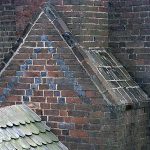 |
Masons in the Wachovia Tract began their work as soon as the Moravian men arrived laying the foundation for the future. There was no pre-fabricated stone available to them and what they used they pulled from the earth. That said, Piedmont North Carolina is home to several indigenous types of rock that lent itself greatly to building. Granite was quarried throughout the Wachovia Tract and was used by Moravian masons in buildings, providing strong foundations for the homes.
Red clay is predominant in the area, and the selection of the location of Salem was made in part to a nearby large brick-quality source of red clay for the easy procurement of building materials. The most difficult item for the early Moravian masons to procure was lime. The nearest source was north of Wachovia near Pilot Mountain and often took days to requisition, which led to early building delays. Once the trading town of Salem became more sustained, lime was kept in stock and most building delays ceased due to its availability. As time progressed and materials became more uniform, the masons of Salem created finer and finer work with their stucco and painted facades that gave the illusion of large colorful bricks.
Melchior Rasp
Born: 8 January 1715
Died: 19 March 1785
Working: 1755–1784
Residences: Salzburg, Austria; Bethabara, NC; Salem, NC
A master mason in both Bethabara and Salem, Melchior Rasp was among the few European-born building artisans in colonial North Carolina whose structures survive to illustrate the direct transplantation of Old World traditions. From 1754 until 1784 Rasp played a central role in the early architecture of the Moravians in the Wachovia settlement of Piedmont North Carolina. His best-known work is the Single Brothers’ House in Salem (Fig. 6), a nationally important example of traditional European Fachwerk (half-timbered) construction.
Born in Salzburg, Austria, Rasp was employed in the salt works as a youth. He moved to Holland at age fifteen, and subsequently moved to Frankfurt-am-Main, Germany, where he learned the mason’s trade. In the early 1740s he settled in the Moravian town of Herrnhaag, joined the Moravian congregation, and worked as a mason for several years. In 1750 he departed for Bethlehem, Pennsylvania, where he stayed for five years, with his major work being Nazareth Hall, a massive masonry school building.
Melchior Rasp arrived in Wachovia on 4 November 1755 and his masonry skills were quickly put to use. The Records of the Moravians for 1 December 1755 noted, “During the first half of the month [November] work was pushed on the new house; Pfeiffer [unidentified] and Melchior Rasp, who had been breaking stone, were appointed to build the wall.”
Rasp’s memoir, a record of his life in the Moravian records, noted, “When the building of Salem was begun, he moved thither with the first Brethren and was the master mason in all the work of that town including the Gemein Haus and the [Single] Brothers House. One could be certain that he intended his work to be useful and permanent.” Rasp and other workmen erected a series of initial Salem buildings in traditional European Fachwerk that included the relatively small First House, Second House, Third House, Fourth House, and Fifth House as well as the large Single Brothers’ House and Gemein Haus (Figure 17), the town’s combination church and meeting place.
As master mason, Rasp was responsible for all the stone and masonry construction in Salem and was assisted by apprentices or untrained local workers as available. On 9 April 1777, for example, the tailor and night watchman Henry Zillman was appointed to help Rasp in placing a tile roof on the Gemein Haus in Salem. Rasp also built masonry foundations and chimneys for numerous buildings, such as the 1771 Miksch House (Figure 18), a log structure covered with clapboards, which was the first residence for a single family in Salem. Rasp also built key buildings in other Moravian communities in Wachovia, including the 1770 Gemein Haus in Bethabara and Bethania’s 1777 tannery.
Rasp was plagued with physical mishaps caused, in part, by the nature of his trade. His health was permanently damaged on one of his trips from Bethabara during Salem’s construction when he fell and drove a pipe stem through the roof of his mouth, a wound that incapacitated him for seven weeks. In 1778, when he was working on a new distillery in Salem, he lost an eye in an accident involving a stone chip. The injury left him nearly blind and afflicted him until his death. Rasp’s expertise, however, continued to be invaluable to the community. He served as a member of the waterworks planning committee and he was appointed as one of Salem’s fire inspectors to check fireplace, stove, and chimney construction and usage.
Even as his age and infirmities took their toll, the Moravian community still relied heavily on Rasp as master mason because there was no one to replace him. In 1779 he was given the assistance of Brother Christian Renetus Heckewelder in building the foundations of woodsheds for the Salem Gemein Haus and Single Sisters’ House (Figures 19 and 20), among other tasks. On 23 May 1780, the records noted, “It might help the walls [of the Second House, a half-timbered structure] to plaster them on the outside if we had someone who could do it for Br. Rasp is too old for such work.” Three months later it was recorded, “At this time it is to be considered that Melchior Rasp is to have a hod carrier so that his work will be easier and cheaper.” On 20 March 1781, to help solve the chronic shortage of masons in Salem, Johann Gottlob Krause was released six months early from his apprenticeship as a potter to enable him to learn the mason’s trade from Rasp. In October 1782, after an eighteen-month apprenticeship as a mason, Krause was designated a journeyman with Rasp his master.
By 1784 Rasp could no longer meet the demands of the position of master mason. In a letter of 15 February 1784, Salem administrator Frederick William Marshall lamented, “We are handicapped by the lack of workmen. Our master carpenter, Trieble [Christian Triebel], is in his seventieth year and our master mason Melchior Rasp in his sixty-eighth year, and both are in the sick room. The latter is no longer able to serve at all.” In December 1784, Krause was named master mason, and Rasp died the nineteenth day of the following March, leaving Krause on his own with only four years of training as a mason. For thirty years Melchior Rasp used traditional skills to build the first generations of substantial buildings in Salem, which defined the town’s early character. Johann Gottlob Krause combined the skills of a mason that he learned from Rasp with other techniques to construct the next generation of masonry buildings in Salem.
Click here to read Melchior Rasp’s entry in North Carolina Architects & Builders: A Biographical Dictionary.
Abraham Gottlieb Steiner
Born: 27 April 1758
Died: 22 May 1833
Working: Unknown
Residences: Bethlehem, PA; Salem, NC
One of the first masons in the Wachovia Tract of North Carolina was the Reverend Abraham Gottlieb Steiner. While Steiner served mostly in an official capacity with the church and as a missionary to the Cherokee, he did aid in early masonry projects. His major contribution was building a stone bridge over Muddy Creek, which served as a connector for those who wished to travel from the Moravian towns of Bethabara and Salem. Steiner also aided in projects among the Cherokee in Western North Carolina, though specifics are not noted in the personnel records.
Christian Renatus Heckewilder
Born: 24 June 1750
Died: 1803
Working: 1766–circa 1774
Residences: Mirfield, West Yorkshire, England; Salem, NC; Bethlehem, PA; Hope, NJ
Christian Renatus Heckewilder was an early mason in Salem. He arrived on 11 October 1766 and within a week announced himself eligible for an apprenticeship, which was the purpose of the visit. By the end of October, Heckewilder was apprenticed to Melchior Rasp to begin learning the mason’s trade.[3] Heckewilder assisted on many of Rasp’s projects during this time, including the First House, Second House, Third House, Fourth House, and Fifth House. He completed his apprenticeship by 1770.
Heckewilder did not pursue the mason’s trade though. He became an intermittent helper in the community store and then the schoolteacher in November of 1774. After teaching, he worked full time in the store of Traugott Bagge.[4] In 1780 he moved to Bethlehem, Pennsylvania, and then Hope, New Jersey, where he worked as a storekeeper until his death.
Johann Samuel Mau
Born: ca. 1752
Died: unknown
Working: 1766–1774
Residences: Salem, NC; Pennsylvania
Johann Samuel Mau arrived in Wachovia in October 1766 and he was quickly indentured to Melchior Rasp as a mason’s apprentice. During this time he learned brickmaking from Brother Merkly.[5] Mau also is noted as laboring in Bethabara as a thresher.[6] In April 1773 Mau completed his apprenticeship and became a journeyman mason.[7] He returned to Pennsylvania in 1774 to work as a mason.
William Gentry
Born: unknown
Died: unknown
Working: 1770–1772
Residences: Salem, NC
William Gentry was a carpenter in Salem in the early 1770s. He worked on several of the first buildings in Salem.
Gentry worked alongside Jens Schmidt and Christian Triebel to determine the location of a bridge over Muddy Creek at the Shallow Ford Road. Gentry was assigned to complete a bridge approximately fifteen feet high by 1 November 1772. This bridge was to be flood proof for at least four years, lest he build another at his own expense. He completed his task of building the half of the bridge on the Salem side of the creek. However the individuals from the Bethabara side had not completed their half, and Gentry was asked to finish the bridge in its entirety.
Johann Gottlob Krause
Entry compiled by John Larson, Vice President of Restoration, Old Salem Museums & Gardens
Born: 18 September 1760
Died: 4 November 1802
Working: 1771–1802
Residences: Bethabara, NC; Salem, NC
Johann Gottlob Krause was the master mason during the construction of the first major brick buildings in the Moravian community of Salem. Representing the first generation of native North Carolina Moravian artisans, Krause introduced construction techniques in the post-Revolutionary era that blended Germanic forms with decorative brickwork adapted from English traditions, and thus shaped the architectural character of this unique community.
Krause was born in 1760 in Bethabara, a frontier village settled in the 1750s in North Carolina’s Wachovia Tract by Moravian pioneers sent from Bethlehem, Pennsylvania. He was orphaned by the age of two. In 1771, Salem’s master potter, Gottfried Aust, adopted him. Thus began a complex and often stormy relationship between two renowned citizens and craftsmen of the Wachovia settlement. Krause ran away from Aust in 1773 but became the potter’s apprentice in 1774. Ultimately, so many disputes arose between the two that the town council removed Krause from the Aust household and provided him room and board in the Single Brothers’ House (Fig. 6); from there Krause was escorted to and from his work at Aust’s pottery. Their problems continued to fester throughout the apprenticeship, which lasted until 1781.
On 20 March 1781, to help solve the chronic shortage of masons in Salem, Krause was released six months early from his apprenticeship at the pottery so he could learn the mason’s trade from Brother Melchior Rasp. Rasp, born in Salzburg, Austria, and trained as a stonemason in Frankfurt, brought an essential Old World skill when he arrived in 1755 as one of the earliest builders in Wachovia. When Rasp received Krause as an apprentice, however, he was 67 years old, blind in one eye and suffering from a variety of illnesses. In October 1782, after an eighteen-month apprenticeship, Krause was designated a journeyman working with the master, Rasp. On 19 March 1785, Rasp died, leaving Krause on his own with four years of training as a mason.
In 1783, Krause began operating the Salem brickyard to make bricks for the proposed Single Sisters’ House (Fig. 19), but after the Salem Tavern burned on 30 January 1784 the community council decided to use the bricks intended for the Single Sisters’ House to replace the tavern instead. The Moravian preference for using congregational members whenever possible for their construction projects limited their options when it came time to rebuild the tavern and although Krause had been trained as a stonemason, an agreement was negotiated for him to construct, as well as supply bricks, roofing tiles, and pavers for the Salem Tavern (1784) (Figure 21)—the first two-story, all-brick building in Salem.
Masonry work on the tavern commenced 16 June 1784 and was completed 11 December of that year. Its masonry details are particularly revealing, for in its construction Krause displayed his training as both a potter and a stonemason. His brick are oversized—measuring 12 inches long, 5-1/2 inches wide, and 3 inches high—and thus require two hands (rather than the usual single hand) to set in place. In this sense, Krause’s bricks function more as clay stones. Moreover, instead of using a single standard-sized brick and breaking some of them to form the closers required to even out a course of brick, Krause—the potter—molded different sized bricks to meet specific needs. Even a filler brick, a unit smaller than a queen closer, was individually molded. At the floor levels, instead of reducing the wall thickness by one brick course, as was normal practice for brickmasons, he used a smaller header brick to reduce the wall’s dimension. In these and other telling details, the tavern displays a craftsman working his way through a series of technical problems during construction.
Four days after the tavern was completed, the community council declared Krause a master mason. He was twenty-four years old. The following year, he completed the Gottlieb Shober House (1785) for a lawyer, entrepreneur, and later postmaster of Salem. The same year and across the street from Shober’s house, Krause constructed the long-awaited Single Sisters’ House (1786) (Fig. 19). He doubled the size of the 1769 Single Brothers’ House (Fig. 6) with a large 1786 addition to its southern end. In all of these projects, Krause employed the same construction detailing and the use of the oversized brick and other unusual techniques he first used at the tavern.
Krause was valuable to the community because of his unique technical skills, which evidently offset his frequently troubled relationships with the congregation. Problems included his purchase of a slave, horse trading, high prices for his work, and the brandy ration he gave his brickyard workers. A conflict between Krause and Gottlieb Shober during construction of the latter’s house even came to blows.
When the post-war building boom slowed in 1786, Krause planned to return to Bethabara and the pottery trade, but the council dissuaded him. He married Maria Meyer in 1786, bought a house, and soon took on various jobs including the position as road master, breaking stones for walls, and making smoking pipes of pottery. In 1787, he asked that the position of master mason be given over to Abraham Loesch, but by April of the following year the council noted, “concerning the bad mason work that is done at times it was suggested to have Gottlob [sic] Krause employed as the master mason.” Trouble with congregational rules, however, continued to mar Krause’s reputation. Finally, after unsubstantiated accusations of taking meat from the tavern smokehouse, Krause chose to leave Salem. In January 1789 he bought the Bethabara pottery, where he lived for the remainder of his life.
Krause’s importance in Salem’s architecture had just begun, however. By 12 September 1793, he was back in Salem to “take over the building of the new schoolhouse”—the Salem Boys’ School (1794) (Fig. 8) and to furnish the brick and roof tile for it. In this two-story brick structure, perhaps influenced by the “stranger” (non-Moravian) workman William Craig, Krause introduced into Salem decorative brickwork the pattern of Flemish bond brickwork with glazed headers that was manipulated to form lozenges, herringbone, and even letters. This was part of a surge of such expert brickwork in the western North Carolina Piedmont that blossomed in the last decades of the eighteenth century and the first few years of the nineteenth century. Such motifs were based in English, not German, craft traditions. Moreover in these decorated gables, as at the Boys’ School, Krause abandoned his oversized brick. Evidently in this project he had learned more than one new technique of the bricklaying trade, perhaps from Craig.
Krause’s next big project took the art of masonry a step further. In the brick Christoph Vogler House and Workshop (1797) (Figure 22), which he built for gunsmith Christopher Vogler, Krause relegated the oversized brick to interior walls, while for the exterior walls he employed a molded brick water table and elaborate use of glazed headers in a chevron pattern at the gable end plus initials worked into the brick walls—all expert brickmasonry techniques that contrasted with Krause’s earlier work. The “W” for Vogler on the front wall and his own “IGK” on the gable end (Figure 23) reflected the Germanic pronunciation and eighteenth-century script worked into the brick pattern—again, techniques based in English and mid-Atlantic traditions applied within a German community.
When the Salem community began construction of its large and elegant brick church, Home Moravian Church (1800) (Fig. 9), planned by the town’s administrator Frederic William Marshall, Krause started producing its roofing tiles in 1798. By 1799 he was both supervising and personally undertaking the masonry work. In the church, the masonry unit was standardized and the techniques were typical of a standard brickmason’s techniques; with Flemish bond brickwork, water table, and belt course. Little evidence remained of Kraus’s earlier techniques. In its scale Home Church was the largest building in Salem up to the 1830s.
Krause built two other large brick buildings in Salem. The Winkler Bakery (Figure 24), like Home Church, was begun in 1799. It reflects Krause’s full assimilation into the mainstream of nineteenth-century masonry and building design with a standardized brick and an increased attention to symmetry. The residence of the Salem physician, the Dr. Samuel Vierling House (1802) (Fig. 12), was the largest private house built in Salem at the time. It mimics the design set by the church in many details, most specifically the use of paint to simulate a more formal rubbed brick at the corners, window, and door jambs. (Some evidence exists that Krause may have also used paint on some of his earlier buildings.) In the gables, however, Krause retained the use of dark headers to form a series of chevrons. The house was completed in June 1802. By the following September, Krause had prepared his will and sold the pottery. He died the morning of 4 November, at the age of only forty-two, leaving a legacy of substantial, handsome, and uniquely crafted brick architecture that redefined the townscape of Salem.
Click here to read Johann Gottlob Krause’s entry in North Carolina Architects & Builders: A Biographical Dictionary.
Johann Heinrich Blum
Born: 19 April 1752
Died: 19 January 1824
Working: 1773–1824
Residences: Bethlehem, PA; Salem, NC
Johann Heinrich Blum was a mason working throughout the late 1700s and early 1800s in Salem. Blum was born in Bethlehem, Pennsylvania in 1752, although not much was documented of his childhood. He and his brother moved to Salem in the late 1760s.
It was in Salem that Blum began his training as a mason along with Johann Samuel Mau under the guidance of master mason Melchior Rasp. On 19 April 1773 Blum was released from his apprenticeship and given the title of journeyman.
The Salem elders considered Blum, along with Melchior Rasp, as an expert on the mason’s profession. It is mentioned in one episode that he and Rasp were asked for their ideas on different types of clay and specific uses. Blum is recorded as working on Salem’s Gemein Haus and a number of unnamed structures in the Moravian settlement of Bethabara.[8] Despite the respect he earned in Salem, Blum elected to “go out on his own.”[9] On 28 August 1775 Heinrich Blum left Salem for Pennsylvania, just two short weeks after the words and news of the Declaration of Independence had made their way to Salem.
While away from Salem, Blum served in the Continental Army aiding in the building of forts. His memoirs reflect on his abhorrence of killing and his thankfulness to never have to take part in such matters. Blum returned to Wachovia around 1788, his memoirs show he suffered from homesickness.[10]
In 1789 he picked up right where he left off as journeyman mason, however Blum’s limitations in brickwork seems to have left him out of favor in some instances to the more versatile Johann Gottlob Krause. This left him in need of money for his family, and Blum attempted several means to make ends meet. In 1790 Blum opened up a stone pit, and in 1791 was asked to man Salem’s kiln to burn tiles for roofs. He began full production of the town’s brick and roof tile needs in the autumn of 1791. By the summer of 1792, through brick making and bricklaying, Blum had paid his debts to the community. By 1794, however, Krause had taken over the brick making position within town.
Blum is recorded to have been working on the Ebert House and Salem’s Home Moravian Church (Fig. 9) between 1797 and 1800, laying stones for the structures. It should be noted that the town seems to have wished for Blum to take up the work of William Craig in order to settle local disputes about overcharging for services. Blum seems to have taken up these jobs without hesitation in order to provide for his family.
In 1800 Blum began work on plastering the Single Brothers’ House (Fig. 6).[11] It is here that is mentioned he worked for less than Johann Gottlob Krause. In 1805 payment records show his work in digging and walling the cellar of the Gottlob Schroeter House. In 1804 Blum worked on the Salem Girls’ Boarding School (Figure 25). There he walled up the rough stone, burned bricks, and pinned the wall plates. Blum was also responsible for laying the foundation for the shed and walling in the bake oven of the school.
Blum worked often with his sons, Abraham and John David Blum. Both of his sons may have carried on his legacy in masonry if not for their early deaths. After his work at the Girls’ School, Heinrich Blum seems to have concentrated his life on brick making and his plantation located outside of Salem proper. He died in 1824.
Heinrich Blum lived a more animated life than many of the inhabitants of Salem. He experienced war and peace, building and destruction. His life was never easy but he rose to the occasion wherever and whenever he was given the opportunity. Much of his work can still be seen standing today in Salem, a testament to this North Carolina builder.
Melchior Fischer
Born: 24 June 1726
Died: 1794
Working: 1774–1794
Residences: Heilbrunn, Wurtenberg, Germany; Lacaster, PA; Freidberg, NC
Fischer was a carpenter but also worked as a mason in Friedburg with his son George Fischer. See entry for Melchior Fischer under Carpenters).
George Fischer
Born: 2 June 1757
Died: 26 January 1832
Working: 1780–1810
Residences: Yorktown PA; Friedberg, NC
George Fischer sometimes worked as a mason with his father, Melchior Fischer, in Friedberg and Salem. He was primarily a joiner (see entry for George Fischer under JoinersJoiners).
Abraham Hauser
Born: 30 August 1761
Died: 27 December 1819
Working: 1782–1797
Residences: Frederick Co., MD; Salem, NC
Abraham Hauser moved with his family from Maryland to Salem sometime before 1782, when he was admitted to the congregation. He expressed a desire to learn a real trade, as opposed to the hunting and fishing lifestyle he had grown accustomed, and was approved to apprentice under Johann Gottlob Krause.[12]
Hauser often quarreled with individuals in the town and was caught spreading a rumor from time to time. This led to strife within the congregation about his conduct. In 1785 he built a farm and house outside of town.
In 1794 Hauser was appointed the roadmaster of Salem and was responsible for maintaining and building the roads, bridges, and fords in the area. He spearheaded a new bridge across Peters Creek in 1795.[13] Unfortunately he did not maintain the roads to the desired specifications and was removed from the position in December 1797.
After his failure as roadmaster, Hauser found it difficult to find work in Salem. His children moved to Indiana in the early 1800s—Hauser, however, remained in Salem until his death in 1819.
Abraham Loesch
Born: 22 August 1765
Died: 16 October 1843
Working: 1782–circa 1820
Residences: Bethlehem, PA; Salem, NC; Bethabara, NC; Bethania, NC
When Abraham Loesch was two years old his family moved from Bethabara to Bethlehem, Pennsylvania.[14] Loesch attended school at Nazareth Hall in Bethlehem and then trained as a mason in Christiansbrunn, Pennsylvania.[15]
Sometime between 1782 and 1785 he moved with his family to Salem. In 1785 he aided in the building of Bethabara Moravian Church, as a mason.
Loesch had an interesting personal life that led to frequent conflict with the local leaders; however, his work was of such quality that he was named master mason at a young age at the behest of master mason Johann Gottlob Krause.
He is recorded in 1786 as beginning to perform mason work on Salem’s Single Sisters’ House (Fig. 19). He likely constructed the chimney on the side of the building, probably for the bake and dry-house.[16] Whether or not he completed the project is unknown because he was undecided about remaining in Salem as a mason.[17] Later that same year, however, he was identified as a mason in a list of Salem’s Single Brethren.[18] Around this time as well Loesch built the bake oven in the Gemein Haus in Salem (Fig. 17).[19]
In May 1787 Krause expressed his desire to name Loesch as master mason. This was done in part because Loesch wished for higher pay and also in part because Krause needed help on the many building projects underway in Salem at the time. Later that year, Loesch was consulted to raise the stone bridge to the Salem’s gun shop.[20]
In late 1787 or early 1788 Loesch was named roadmaster in Salem but he was not content with the position and his tenure was short lived.[21] [22] In 1788 he traveled back to Pennsylvania and learned the fulling trade. In 1789 he returned to Salem and constructed his own fulling mill and house.[23] He became a full-time fuller, holding the rights to indigo dye in Salem and only performed mason work on the side when time allowed.
In the summer of 1791 Loesch was hired to do the mason’s work on the Peters Creek bridge. He seemed adept at building bridges as there is a mention of his bridge being the only one across Muddy Creek that was accessible during flooding. By 1793 Loesch had built a house in Bethania where he also located his new fulling and saw mill.[24] Loesch was appointed in 1807 to oversee the construction of the Bethania Moravian Church. He also was placed in charge of hiring the workers who would construct this building. In 1815 and 1816 Loesch placed newspaper advertisements for platforms, water pumps, and piping as far away as Raleigh in the Raleigh Star and North Carolina State Gazette.[25] [26]
Abraham Loesch died in 1843 and his work can still be seen today in the Moravian churches in Bethabara and Bethania.
Click here to read Abraham Loesch’s entry in North Carolina Architects & Builders: A Biographical Dictionary.
Johann Michael Seiz Jr.
Born: 6 March 1765
Died: 17 May 1792
Working: 1784–1788
Residences: Broad Bay, ME; Bethania, NC
Johann Michael Seiz Jr. was born in Maine and moved to Bethabara in 1769 with his father along with about three hundred other Moravians who chose to relocate to Friedberg, North Carolina.[27] Seiz began to learn the linen weaving trade in 1782, but two year later he began another apprenticeship, under Christian Triebel, to learn the carpenter’s trade.[28] At some point between 1784 and 1785 he switched to masonry, learning under Johann Gottlob Krause. He completed this apprenticeship under Krause, along with fellow apprentice Abraham Hauser, and in 1785 was regarded as a journeyman mason.[29]
In 1786, Seiz, Krause, and Abraham Loesch, ventured out of Salem to make lime, a building commodity nearly always in short supply in eighteenth-century Salem. This enterprise seems to have been an attempt to supply lime for their work on the Single Sisters’ House (Fig. 19).[30] Seiz worked a few masonry jobs in Salem during 1787, including helping to lay stone for the Lick-Boner House and the Traugott Bagge House, but Krause, the master mason in town, received most of the project. Because of the lack of work for the journeyman masons in Salem—Seiz, Abraham Loesch, and Rudolf Strehle—in October 1787 the church adminstrators offered them the job of breaking and stacking rocks with permission to sell them to customers over the summer building season.
In April 1788 Seiz took over the old Hege plantation and married Catherine Hauser. The Aufseher Collegium mentions that he spent the rest of his days as a farmer.[31]
William Volk
Born: 27 June 1741
Died: unknown
Working: 1784–unknown
Residences: Pennsylvania; Salem, NC
William Volk was a mason in Salem, North Carolina. He was born in Pennsylvania. He worked alongside Johann Gottlob Krause on projects in 1784. He also worked with David Blum on the building of the home of the Boarding School inspector. However, he was not welcomed by the Salem Community proper due to conditions of character.
William Craig
Born: unknown
Died: unknown
Working: 1794–circa 1820
Residences: Salem, NC
William Craig, a brickmason who worked in Salem, was an “outside mason” or “stranger,” meaning not a Moravian, whose skills had a lasting impact on the brick architecture of the community. He worked closely with master mason Johann Gottlob Krause and may have introduced patterned brickwork into Salem. Although Craig was evidently highly skilled, he is an enigmatic figure: Nothing is known of Craig’s background, and, likely because he was not a Moravian, the church records give little information about him, his origins, or his family.
The first documentation of William Craig in Salem appeared on 24 April 1794 when the Aufeseher Collegium minutes noted, “we have heard that Gottlob Krause has accepted William Craig for mason work at the new school house construction… .”[32] According to the minutes, the acceptance of Craig as an apprentice or employee met with disapproval from the community and Krause was urged to reconsider. But on 6 May 1794 the minutes noted that the community grudgingly accepted his appointment.
The project that Craig was hired to assist in construction was the Salem Boys’ School (Fig. 8). The building displays Flemish bond brickwork with glazed headers that form decorative patterns, a distinctly different manner of laying brick from that employed in Salem previously (Figures 26 and 27). Craig may have shown Krause this new method based on his experience learned elsewhere. Such work was often seen in areas of Anglo settlement, such as New Jersey, but had not appeared in Salem before the Boys’ School construction. After its introduction in Salem, the use of glazed headers to form decorative patterns would become popular in the western Piedmont of North Carolina both English and German households.
Craig employed a more efficient way of laying brick than the method Krause had employed, which shared much more with the potter’s trade than a traditional bricklayer. Craig, like many brickmasons, also undertook work in whitewashing and plastering. He was recorded as whitewashing the rooms of Brother Frederic Marshall in 1795. A year later Craig was employed to plaster the house of “Sister Transou,” by prominent community member Christoph Vogler.
Craig’s most substantial project in Salem was construction of the residence for the church’s administrator, the 1797 Vorsteher’s House. He was given this task in its entirety, from laying the foundation to raising the roof. Town leaders found his work to be too costly and demanded lower pay for workers. Craig and the church administrators eventually came to an agreement and construction commenced. The Vorsteher’s House is a three-story brick structure set into the hill adjoining Main Street. It follows a central-hall plan, with detailing akin to its contemporary congregational buildings in Salem.
Craig was employed in 1798 to work on the foundations and “drawing up the walls” of Salem’s Home Moravian Church (Fig. 9).[33] [34] The mason’s work was noted as being particularly difficult as the slope of the building site was steep and the basement rooms, including the kitchen, required special attention to their construction. The task was cited as consuming more than 300,000 bricks with some of the work as high as thirty feet. Later in 1798, Craig fitted the stone plates for stairs, windows, door sills, and other tasks in completing the church.
Shortly after working on the Home Church, Craig left Salem. It seems that problems with the high wages he requested came to a head and he was asked to leave the community. The United States Census of 1820 lists a William Craig—possibly the same man—living with his family in Salisbury, North Carolina. Other than that census record, his whereabouts after leaving Salem are not known—nor is it known whether Craig was involved in any of the decorative brickwork on the various early federal-period brick houses and chimneys constructed in the western Piedmont of North Carolina.
Click here to read William Craig’s entry in the North Carolina Architects & Builders: A Biographical Dictionary.
John David Blum
Born: 21 March 1787
Died: 13 November 1860
Working: 1802–1842
Residences: Schöneck, PA; Salem, NC
David Blum was part of the second wave of construction in the congregation town of Salem that began in the nineteenth century. He was apprenticed to his father, Johann Heinrich Blum, where he learned the mason’s trade in 1803.[35] His father and he worked on several buildings together. In 1804 he aided in the construction of the Salem Girls’ Boarding School (Fig. 25). His father is documented as walling up the rough stone, burning bricks, and pinning the wall plates for the building. John David Blum was also responsible for laying the foundation for the shed and walling in the bake oven of the school. In 1805 he aided his father in the work of digging and walling the cellar of the Johann Gottlob Schroeter House on Main Street in Salem.
In 1805 Blum was apprenticed to Brother Christmann to learn the cooper’s trade.[36] Three years later, in 1808, he petitioned for the ownership of the plantation of Brother Opitz. His request was approved and he was given responsibility of running the plantation as well as making bricks in the summer months for use in construction of Salem’s buildings.[37]
Blum worked on the construction of the 1811 Inspector’s House, the residence for the headmaster of the Salem Girls’ Boarding School.[38] In 1823 he requested several acres of land on the Salem Tract to begin brick making in earnest, however this request was refused by the Aufseher Collegium as the land was deemed not suitable for such a purpose.[39] Two years later Blum was granted permission to build a schoolhouse near the northeast corner of the Salem Tract. Blum built a new house on their plantation in 1830, however his wife Sarah passed away before it was completed.[40]
Blum sold his plantation in 1842 and a few months later, in June 1843, he began building a home in the town of Salem.[41] The house was noted for its large size. He requested to open a store in Salem, but had his petition declined. Instead, John David Blum occupied himself as a mason in the surrounding area, finding work where it was available until a few years prior to his death in 1860.
William Hauser
Born: 1 July 1802
Died: unknown
Working: 1802–unknown
Residences: Bethania, NC; Salem, NC
William Hauser’s entrance into Salem came in February 1824 when Jacob Christmann hired him for a four-week project. His employment was accepted by the Aufseher Collegium under the condition his behavior be proper, hinting that his childhood had been rambunctious. His conduct was superior enough to earn him an apprenticeship under Christmann, and as a result Hauser was allowed to become a member of the Salem community.
In March 1828 Hauser left Salem to spend two years in Philadelphia learning the bricklaying and plastering trade.[42] He was allowed to keep his membership in the Salem congregation during this time as there was a noted shortage of masons in the community.[43] This was a rare honor because most individuals who left the town would be forced to reapply for membership upon their return to the community.
Hauser was forced to make a career decision in 1831 shortly after his return to Salem. Christmann was being dismissed from the congregation and as a result Salem was losing its only wheelwright. Under pressure from the Aufseher Collegium, Hauser had little choice but to open a wagon-building shop.[44] He built wagons only in the winter months while continuing his masons work during the warmer seasons. He continued this pattern for several years, serving as the only wheelright in town according to the records.[45]
In 1839, Hauser agreed to continue the wheelwright trade if allowed to build a house in Salem. This request was approved and Hauser was granted a plot of land at the corner of Main Street and Belews Creek Street. In 1841 he continued to expand on his grounds, building a two-story wheelwright shop.[46] Hauser proposed to build a new Salem house in 1845—whether or not this was allowed is not known. Four years later Hauser purchased a lot of land outside of the Salem town boundaries to sell lime and bricks. Lime had always been an item in short supply in Salem, with the nearest mines over thirty miles away, but demand had eased as the number of building projects in Salem declined. No further information is available for Hauser after 1858.
Pleasant Roberts
Born: unknown
Died: unknown
Working: ca. 1803
Residences: Bethania, NC; Salem, NC
Pleasant Roberts was a mason from Surry County, North Carolina who worked in Salem, North Carolina and was active around 1803. He was contracted as the master bricklayer for the construction of the Market-Fire House in Salem in late April 1803. At the same time Brother Stotz also contracted him as bricklayer for the Girls’ Boarding School (Fig. 25) in Salem.
Carpenters
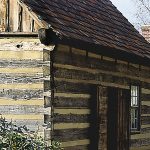
Carpenters, along with masons, were the greatest contributors to the construction of the town of Salem. Using Germanic traditions, the carpenters were responsible for raising and forming the interior and the exterior of the homes. With hearty local timber of oak, tulip poplar, walnut, and pine, Salem’s carpenters had all the materials they needed for the massive construction projects in the town.
The Moravians used different terms for erecting log buildings (which they called Aufgeblockt) from raising a framed structure (Aufgeschlagen). The Moravian leaders viewed frame structures to be superior to log construction.[47] To erect substantial framed structures required the skills of a trained carpenter.
George Holder
Born: 27 January 1729
Died: 15 January 1804
Working: 1754–1768
Residences: Oley, PA; Bethabara, NC; Salem, NC
George Holder spent his formative years in Pennsylvania learning the carpenter’s trade. He moved to Bethabara on the 26 October 1754. In 1766 he was among the men who walked from Bethabara to the site of the town of Salem in preparation for construction. The other men were Niels Petersen, Jens Schmidt, Gottfried Praetzel, John Birkhead, Jacob Steiner, Melchior Rasp, and Michael Ziegler. Their directive was to “remain there for the time, in order to make a real beginning of building.”[48]
Their first project was construction of the Salem Builder’s House, begun on 6 January 1766. Together with Christian Triebel, the men laid most of the beams for the house. This building was a simple log cabin style home that served as the builder’s shelter through the end of the winter and into the summer.[49] The men were in favor of building a real house, not a temporary structure.[50] As such, the house was built 26 feet by 22 feet with a tile roof and made weather tight.[51] This structure remained standing until around 1907.
Holder also had a hand in felling the trees and preparing the lumber for the Outsider’s Cabin on the same lot as the Salem Builder’s House.[52] This house was to be occupied by all the hired workmen who did not belong to the Moravian congregation. He aided in the completion of the First House, in which he lived for a time, and served as the bush-ranger in order to find roads and paths that led to Salem. He mapped these routes to aid in expediting travel between the Moravian settlements of the Wachovia Tract.[53]
Near the end of 1766 Holder made the clapboards for the horse stables in Salem. Two years later, after being appointed overseer of roads, he was hired to chop out the roads to Town Fork and Belews Creek. These roads are documented as being supposed to be good enough for riding.[54] After serving as bush-ranger, Holder was granted a tract of land by the town council to have a farm. He finished his days as a farmer, practicing joinery here and there, and was responsible for the completion of many of the buildings on his land. He died 15 January 1804 in Bethabara.
Jacob Steiner
Born: 1734
Died: 1801
Working: 1755–1777
Residences: Warwick Township, Lancaster, England; Bethabara, NC; Salem, NC
Jacob Steiner arrived in Wachovia on 13 June 1755. The Wachovia Diary says that Steiner came to the new town (Salem) with seven other brethren, Niels Petersen, Jens Schmidt, Gottfried Praetzel, John Birthed, George Holder, Melchior Rasp, and Michael Ziegler. Here he aided in the carpentry on the 1766 Salem Builder’s House and later that year he helped Christian Triebel with some of his carpentry projects.
In 1773, worked on construction of a mill that he owned in partnership with the Moravian Church (Wachovia Diacony).[55] He also built the Miller’s House in order to house himself, his wife, and those helping to build the mill. This mill was built just outside the boundaries of Salem, as Steiner was not considered a resident of the new town. He owned a 1/3 stake in the mill while the church held the rest.[56]
Steiner also assisted in construction of the Salem Saw Mill in 1777. Here he invested time and capital into the building in order to become a partner in the enterprise. The Aufseher Collegium recorded, however, that he did not want to own the enterprise entirely. After working as a carpenter on Salem’s first buildings, Steiner returned to the milling, the trade he would practice for the remainder of his life.
Christian Triebel
Born: 6 November 1714
Died: 16 April 1798
Working: 1755–1788
Residences: Henneberg, Thuringia, Germany; Bethlehem, PA; Bethabara, NC; Salem, NC
Christian Triebel was a master carpenter who, like the mason Melchior Rasp, brought his Old World skills to the Wachovia Moravian settlement in North Carolina and helped construct buildings in Salem and elsewhere that represent the state’s sole surviving examples of European building traditions transferred directly to colonial North Carolina. Among his best-known surviving works is the massive, half-timbered Single Brothers’ House (Fig. 6) in Salem, which exhibits Treibel’s skills in traditional heavy framing that defined Salem’s early architecture.
Little is known of Triebel’s early life, except that in his memoir he recalled his younger days as something of a hooligan in Henneberg, Germany before he affiliated with the Moravians and converted to a pious life. He left Europe in November 1754 and spent a brief period in Bethlehem, Pennsylvania. He arrived in Bethabara from Bethlehem on 11 October 1755, just two years after the pioneering group of Moravians began the community in 1753. In early November 1755, Triebel was joined in Bethabara by the mason Melchior Rasp, and they and other men kept busy constructing buildings in Bethabara.
After the site was selected for the new principal town of Salem in 1765, Triebel, at age fifty-one, faced what must have been the greatest building challenge of his life: the construction of a new town in the wilderness with substantial and well-crafted buildings erected using traditional techniques. In January 1766 Triebel was a member of the first crew of workmen sent from Bethabara to Salem to construct a temporary log house for the workmen. By March of that year he was busy selecting timber for the first permanent buildings in Salem, and on April 22 Triebel and his apprentice Rudolf Strehle went to Salem and “began work on the framing for the first house to be built.” Salem’s Community Store (Figure 28) owner Traugott Bagge said of Triebel in November 1766:
Br. Triebel is surely a faithful brother on his part, and although he often has much to object to and expresses himself somewhat roughly, it must be said that he has worked very hard at his trade, made harder because he has always been alone and that is just now for us and for him the most difficult thing in Salem. Otherwise I regard him as one of the most faithful in the Choir.
Triebel’s skills were essential to construction of Salem’s half-timbered buildings, which employed traditional techniques he learned in Europe. Raising the heavy structures was sometimes dangerous, especially for the larger structures. On 8 January 1766, while Triebel and other men were erecting the Salem Builders’ House, “Br. Triebel, chief carpenter, fell from top of wall while helping place the roof timbers, not hurt.”[57] In 1769, while “raising the Single Brothers house in Salem, a piece of timber fell, taking with it a wall which was not yet secured; it might have swept a number of Brethren from the second story to the ground, or have crushed others as it fell, but the angels guarded them and no one was hurt.”[58] In October 1779, Triebel broke his leg in a fall while working on the Bethabara mill; this injury plagued him for the rest of his life.
By 1769, with seven dwellings, a workmen’s house, tannery, and the large Single Brothers’ House constructed, Salem’s administrator Frederick William Marshall began consulting with Triebel and Melchior Rasp on construction of the town’s principal congregational building, the Gemein Haus, to serve for worship, community meetings, and other purposes. Rasp constructed the first story of stone and Triebel framed up the second story in the half-timbered method used for the previous buildings. The Gemein Haus was completed in 1771 and in 1772 Salem was deemed ready to accept the Moravians who were assigned to move from Bethabara to practice their trades in the new town. In 1774 Triebel built a house at his own expense on Lot 59 in Salem (at the corner of present Academy Street and Main Street). This structure was approved by the Congregational Council on the condition that Treibel would house the night watchmen in an upstairs room, which he did for several years.
For some projects, such as a bridge over Muddy Creek, the congregational leaders contracted with outsiders after consultation with their master carpenter Christian Triebel. But in 1775, while planning construction of the waterworks, which involved a system of wooden pipes to deliver water to Salem, “it was not approved to give the contract to an outsider and Triebel, Krause and Frederick Beck said they would do the work for the price named.” The contract drawn up with Triebel in 1776 stipulated, “to square the wood, we keep the old price i.e. per 100 ft. 12 sh. [shillings]. As to the other carpenter work we shall make a special contract with him.” In December 1777 Triebel, Johann Gottlob Krause, and another man stated that they were “willing to undertake the bringing of water pipes to the town… Br. Triebel has agreed to cut and bore the pipes according to directions and a contract will be made with him per yard.” It was agreed that he should have “4d. Congress money for each log he cuts for pipe and 3.5d. of old money for each foot bored.” (The difference in the money referred to the financial situation during the American Revolution.)
In early January 1778 Triebel was cutting trees for the waterworks project, which at age sixty-four must have been demanding work even with the help of his apprentices and other men. By mid-month, he asked the governing board for a dollar more per log than agreed upon (possibly reflecting wartime inflation). The adjustment was made, and by February he was boring pipe again. But the American Revolution, other construction work, and an accident at the Bethabara sawmill slowed his progress on the waterworks.
During the war years, Triebel busied himself making gutters for the Gemein Haus and the store. He also supplemented his income by selling gravestones and making well pumps. During the war, troops were housed in his home, and later part of it was rented to the Salem Boys’ School (Fig. 8). Also, in 1780 Triebel entered a contentious period when another man wanted to buy his wood-boring equipment and replace him at pipe making. Triebel refused and continued making the pipes until the mid-1780s. Triebel also worked as a gravestone cutter, and although this task was seldom mentioned in his records, it is noted that he fashioned and sold stone markers—which in the Moravian tradition were simple square or rectangle markers inscribed with only the name and lifespan of the deceased.
As the postwar building boom accelerated, Salem again required the master carpenter’s construction skills. In February 1784, Frederick William Marshall lamented that the community was “handicapped by the lack of workmen.” “Our master carpenter Triebel, is in his seventieth year,” Marshall wrote, and Triebel was being treated alongside master mason Melchior Rasp “in the sick room.” Triebel evidently recovered sufficiently to serve Salem for a few more years. The congregation called on him to assist in completion of the new, brick Salem Tavern (1784) (Fig. 21), for which Johann Gottlob Krause was the brickmason. For the 1786 Single Sisters’ House (Fig. 19), another large brick building, it was decided “to keep Triebel for the frame work of the Sisters House because we are doubtful to leave this to Strehle [Triebel’s former apprentice] by himself.” Triebel responded that he was “willing to help with the construction as much as possible for 4 sh. [shillings] a day.” This was the last project in which Triebel was mentioned; with his health failing and his old leg injury troubling him, he was no longer able to work, and his memoir states that he was forced to give up his trade about 1786 or 1788. He had employed his skills to make an entire town rise in the wilderness, and his surviving works represent some of the principal examples of first-generation German immigrant architecture from colonial America.
Click here to read Christian Triebel’s entry in North Carolina Architects & Builders: A Biographical Dictionary.
Rudolf Strehle
Born: circa 1751
Died: unknown
Working: 1764–1790
Residences: Bethlehem, PA; Bethabara, NC; Salem, NC
Rudolf Strehle was born around 1751 and arrived in Bethabara on 1 November 1764 with his family. He is first listed as a carpenter in the “Boys and Prentices” section of the list of inhabitants of Bethabara in Wachovia.[59] He is identified in November of that year as apprenticing with Christian Triebel.[60] He commuted from Bethabara to Salem while working with Brother Triebel on the first buildings of Salem. He then moved permanently to Salem in 1772.
Strehle worked with Triebel closely for years. He is recorded with Triebel constructing the Salem Gemein Haus shingles in 1777 and a year later cutting logs suitable for water pipes for use in and around Salem. He is listed working on a building with fellow carpenter Martin Lick in February 1781.[61] A week later Strehle was asked to fill the night watchman position, which he accepted and filled for several months. Near the end of 1781 he was sent to Bethabara to help the American military forces of General Pickens, likely to aid in the wooden fortifications of the area.
In 1785 Strehle worked on the frame work of the Single Sisters’ House (Fig. 19) with Christian Triebel.[62] In October 1785 he, along with Martin Lick, built an addition to the Single Brother’s House so that they could continue their carpenter and joiner work in foul weather.[63] Strehle and Lick were both caught accepting work outside of Salem without notifying the congregation, an act that was not viewed favorably by the church administration. Both men were criticized for seeking too much money for their work based on this decision.[64]
In 1786 he, along with Lick made the guttering for the Gemein Haus in Salem. He is later listed as breaking stones with Brothers Abraham Loesch and Johann Michael Seiz Jr. for the summer building season.[65] 1789 saw Strehle working on several pumps for various inhabitants of Salem. He worked on the pump at the home of Brother Herbst as well as the Single Sisters’ House. In the spring of 1790, Strehle moved to Bethlehem, Pennsylvania, in search of more steady work than he was able to find in Salem.
Niels Petersen
Born: 3 April 1717
Died: 4 November 1804
Working: 1766–1774
Residences: Oddes Brandrop, Danish Holstein; Bethabara, NC; Salem, NC
Niels Petersen was born in what is now Denmark in a town that bordered today’s Germany, where he was introduced to the Moravians. He arrived in Bethabara from Charleston, South Carolina, on 30 January 1766. He was sent to North Carolina to serve as Bethabara’s first distiller but before he could produce any spirits he first worked to build the town of Salem.
Petersen aided in the building of the Salem Builder’s House and then went to work planning and building the town’s distillery. It was as Salem’s distiller, not Bethabara’s, that he practiced his craft for most of his life. Petersen’s work ethic was well recognized in town and in 1774 he was appointed to the committee to construct the waterworks of Salem. This was one of the most important projects in the town and also one of the first water programs undertaken in the American colonies.
Petersen also seems to have had skills for resolving conflicts. He mediated a dispute between Johann Gottlob Krause and Gottfried Aust that resulted in Krause returning to his foster father to learn the potters trade. Without Petersen’s intervention, the career of one of Salem’s most prolific and influential brick masons may never have been realized.
David Holzapfel
Born: circa 1750
Died: February 19, 1856
Working: circa 1770–1856
Residences: Broad Bay, ME; Friedland, NC
David Holzapfel came with his wife to the Lutheran colony of Broad Bay, Maine in 1742. This was a Lutheran settlement established by General Samuel Waldo. Two years prior to Holzapfel’s arrival, the colony had suffered a devastating attack by Native Americans allied with the French during King George’s War.
Holzapfel was a carpenter by trade, and built the first frame house in Broad Bay. There they lived until 1772 or 1773, when the couple along with around three hundred others moved to Friedland, North Carolina. He built his own frame house in Friedland, another frame house. Holzapfel was familiar with the Moravian Church but was not considered a member.
When the American Revolution came about, Holzapfel joined the fight, likely emboldened by the war stories from Broad Bay during his younger years. Holzapfel was a part of Washington’s Continental Army. He used his carpentry skills to repair and improve the fortifications of Fort Ticonderoga. He suffered through Valley Forge and crossed the Delaware with Washington during the attack on Trenton.
Holzapfel returned from the war and engaged in putting his carpentry skills to constructing buildings in the surrounding community on into the nineteenth century. Not much is recorded about his later life, Holzapfel died at the age of 106 on 19 February 1856.
Melchior Fischer
Born: 24 June 1726
Died: 1794
Working: 1774–1794
Residences: Heilbrunn, Wurtenberg, Germany; Lacaster, PA; Freidberg, NC
Melchior Fischer trained in carpentry in Germany and came to America in 1750. He settled in Lancaster, Pennsylvania, where he served as a master carpenter for three years. Fischer was among the group of original builders in the Wachovia Tract who brought the artfulness of the Old World style to the New World.
Fischer moved to North Carolina in 1774. He and his family settled in Freidberg. His son George Fischer worked as a joiner in Friedberg and Salem.
Martin Lick
Born: 11 November 1759
Died: 4 January 1834
Worked: ca. 1777–1789
Residences: Bethabara, NC; Salem, NC
Born in Bethabara in 1759, nothing else is known of Martin Lick’s childhood until he moved to Salem in 1772 and entered the Single Brothers’ House to learn the trade of a joiner.[66] After serving a joinery apprenticeship for several years, Lick decided to pursue the carpenter’s trade. He was allowed by the church adminstration to do this if he agreed to make the window frames for the Single Sisters’ House (Fig. 19) under master cabinetmaker Johann Krause.[67] At the time, however, Krause did not wish to take an apprentice and Christian Triebel was consulted on the matter. Triebel was too old, so Lick was apprenticed instead to Frederick Beck, a master joiner.[68]
However, sometime between 1775 and 1780 Krause consented to taking Lick as his apprentice in carpentry. Lick worked as Krause’s apprentice until 21 November 1780 when the two men went through the customary ritual of exchanging indenture papers, a show of an apprentice’s freedom from their master.[69]
In February 1781, Lick and Rudolf Strehle were sent to help the Brethren in Bethabara, where General Pickens’s American forces were stationed. They were likely working on the wooden fortifications near the town as well as providing general support to the Continental Army.
Lick made several attempts at increasing the amount of carpentry and joinery work he received in Salem. He often partnered with Rudolph Strehle, another woodworker, who was released from his apprenticeship around the same time as Lick. The men attempted to establish their own space around the Single Brothers’ House (Fig. 6), and were successful in building an outdoor workshed.[70]
An interesting note in Lick’s records was his request, along with others by carpenters in Salem, to be compensated for the cost of his tools. The town’s administrators determined that the carpenters would not be compensated for their hatchets, axes, adzes, hand saws, and squares. Any other tool needed for specialty work, that typically only a master could afford, would be paid for in part by the community.[71] Lick was often in trouble for taking work outside of the community for rates higher than those approved by Salem. Lick was frequently financially strapped throughout his life and seeking work outside of Salem was his attempt to build a name for himself and his business.[72] Lick was listed as a cabinetmaker and carpenter among Salem’s Single Brothers, reflecting that he maintained his good status among the Moravians in order to give him the most options for his carpentry work.
In August 1786 Lick and Strehle were given the task of making the roof spouts for the Salem Gemein Haus.[73] In December of the same year he was tasked with adjusting the roof elevation of his own home, which prompted him to request the right to build a house in Salem. He built what is now known as the Lick-Boner House as his personal residence.[74] Lick’s house was originally a log structure with a central chimney. Below there was one room at the north end that also served as the entrance. On the south end there were two rooms and above was a loft. The same floor plan has been found in one other house in Salem: the Chimney House, built in 1789 by Abraham Loesch. While following the same plan as Lick’s house, the Chimney House was built on a larger scale. The chimney girth construction—possibly unique to these two old houses in Salem—spanned the length of the house and is supported in the middle by the chimney.
Lick seems to have had a close relationship with cabinetmaker Johann Krause and likely worked alongside him on several projects. In 1788 Lick was appointed as Salem’s roadmaster. In early 1789 the mason Johann Gottlob Krause planned on closing his brick kiln in Salem. Lick was asked if he would be willing to take up the job of making bricks and roof tiles in place of Krause. Lick initially agreed but a day later decided not to accept the position.[75] In April 1789 Lick took over Krause’s position maintaining the waterworks in Salem.[76] Later that year he took over the position of forester in Salem, making him responsible for all the cultivation of trees in the town and surrounding area.[77]
Continued financial problems forced Lick to move his family from Salem to Bethania in the 1790s. He remained in Bethania for the remainder of his life, although his children were admitted to the Salem community to pursue various jobs throughout town. The last mention of Lick working as a carpenter is found in October 1804 when he was employed to repair Brother Vierling’s parent’s house, as well as work on the Miksch House (Fig. 18).[78]
Johann Michael Seiz Jr.
Born: 6 March 1765
Died: 17 May 1792
Working: 1784–1788
Residences: Broad Bay, ME; Bethania, NC
Johann Michael Seiz Jr. learned the carpenter’s trade but switched to masonry (see entry for Johann Michael Seiz Jr. under Masons).
Jacob Spach
Born: 1 April 1768
Died: 2 February 1856
Worked: ca. 1786–1856
Residences: Freidburg, NC; Salem, NC
Jacob Spach was born in Friedberg to Adam Spach and Mary Elisabeth Spach. He moved to Salem in November of 1783.[79] He was first employed by Johann Heinrich Herbst at the tannery and worked there for three years until a dispute with a coworker in the tannery forced him out. Spach then trained as a carpenter after moving back to Friedberg. In 1815 he and George Fischer built the wooden frame for the Salem Tavern (1784) (Fig. 21) boarding house. He is later recorded in the Friedberg Diary as the contractor for the building materials and construction of the new Friedberg Moravian Church.
Charles Alexander Cooper
Born: 22 March 1810
Died: 1866
Worked: 1831–ca. 1850
Residences: Germantown, NC; Salem, NC
There is not much known of Charles Alexander Cooper’s early life in Salem. He is mentioned on occasion in the Salem records and seems to have been a mischievous young man who often got up to no good. In 1821 he petitioned to apprentice under Charles Abraham Steiner to learn the turner’s trade.[80] He again expressed his wish to become a turner, as well as a joiner, in the early 1830s. Cooper found himself initially rebuffed by Salem’s leaders as there was an abundance of joiners in Salem. In 1831 he turned aside his ambitions to become a furniture maker and worked as a bar keeper for Salem Tavern for one year.
Questions arose about whether or not Cooper had been employed as a house painter in August 1831 without church approval.[81] Ultimately, Salem’s administrators granted Cooper permission to pursue house painting for compensation.[82] While several buildings in Salem were painted at the time no records exist to definitively place Cooper at any particular site.
In 1833 Cooper asked for permission to begin making furniture. He seemingly did well at his trade. In 1834 he purchased a house from the widow Schulz.[83] Cooper intended to expand his operations, and on 4 August 1834 he opened his new cabinetmaking shop. This shop followed a growing trend in Salem at the time of detached businesses and shops, as opposed to the in-residence locations that had previously been the norm. The shop is “a two-story, two-bay, front-gable weatherboard frame structure on a parged foundation. Wooden steps across the unprotected single leaf paneled wood door.”[84] It features nine-over-six windows. The roof is finished with wood shingles.
1839 saw Cooper plan to build an additional outbuilding to his lot that measured fourteen feet; although the structure was approved by the Aufseher Collegium, there is no indication the project ever started. In 1840 he made major alterations to his house by adding twenty feet to the south end, a second story, and a rear porch. Cooper is mentioned several times requesting to add outbuildings to his property, some of which were for a bake oven and a smoke house (September 1851).[85] In 1852 he expanded his shop with a second story.
An election of Salem’s Aufseher Collegium in 1843 saw Cooper elected to the board. On 10 January 1843 Cooper was appointed to be a fire inspector for the town.[86] He advised Peter Philip Fetter about the latter’s turners shop in August 1843.[87] Cooper was asked by the Aufseher Collegium on a number of occasions to appraise houses. Such requests display the trust and respect Cooper had among Salem’s administrators.
During the last twenty years of his life Charles Cooper was assigned various tasks within the community. Being responsible for all necessary repairs for the Salem’s Home Moravian Church (Fig. 9) was one of these important tasks. He also inspected the Single Sisters’ woodshed to determine whether or not it would need rebuilding.[88] He died in 1866 at the age of fify-five.
Joiners

Joiners in Salem were versatile workers who were a hybrid of both carpenters and cabinetmakers. Responsible for fashioning tables, chairs, shelves, desks, and case goods inside homes as well as window sashes and doors for the exteriors of buildings, joiners in Salem kept true to their Germanic roots employing simplicity in form and solid construction. Function was also a concern of the joiners with attention given to detail. Operating in a large woodshop behind Salem’s Single Brothers’ House (Fig. 6) early on, many joiners opened their own shops in the early nineteenth century and specialized in different aspects of the trade.
John Jacob Wohlfarth
Born, 5 August 1755
Died: 4 August 1807
Worked: 1769–1807
Residences: Broad Bay, ME; Boston, MA; South Carolina; Salem, NC, Hope, NC; Friedland, NC
John Jacob Wohlfarth was a joiner in Salem’s early history. He was born in Broad Bay, Massachusetts (now Maine) and was bound as an apprentice baker in Boston. At the age of 14 he sailed with his family down the coast of America to the South. His ship was wrecked off of the coast of Virginia but his family survived the ordeal.
Wohlfarth’s father had died at the Battle of Quebec during the French and Indian War. His step-father, Adam Schumaker, was reportedly not fond of the young John. In November 1769 he was taken as an apprentice by Jacob van der Merk. Wohlfarth aided van der Merk in building a mill in South Carolina while in service to him. When van der Merk died in 1783, Wohlfarth was taken as an apprentice by the joiner Andreas Brosing. He was promoted to journeyman in 1775 along with his peer, Martin Lick. Wohlfarth was drafted into the Continental Army in 1778, however the Moravian community paid for his, and his compatriots, fines to escape the war and military service.
Wohlfarth worked in the joiner shop in Salem full time soon after being promoted to journeyman. He was also active in civic service being Overseer of the Boys and appointed as a member of the Congregation Council. Throughout the decade Wohlfarth held several civic positions including positions on the Helper’s Conference and Aufseher Collegium. In August 1788 he was called to Hope, North Carolina to serve as the preacher. He is noted serving from time to time in the outlying towns around the Wachovia tract whenever needed.
By the early 1790s Wohlfarth set up shop in Friedland, North Carolina and transitioned to making wagon bodies, grave stones, and coffins. Wohlfarth would also work in Salem as there was a shortage of joiners in the town at this time. Although Wohlfarth was never named Salem’s Master Joiner, even when he was asked to run the joinery shop at the Single Brothers’ house, he trained a number of young men as joiners, including Neman van Zevely. Wohlfarth worked in a variety of capacities during his time in Salem, likely leading to him not being able to concentrate on perfecting his finer joinery skills.
In 1801 Wohlfarth was called to the pastorate in Friedland full time after having traveled to preach and teach there over the years. Later in 1801, he joined Brother Byhan to mission to the Cherokee. This seemed to become a passion for Wohlfarth as he later served on several more missions for increasingly long periods of time between 1803 and 1805. He died in 1807 and it was reported the service was held outside the church as the building could not hold all those who came.
Andreas Brosing
Born, 5 April 5 1742
Died: 25 January 1827
Worked: 1770–1781
Residences: Colm, Upper Lusantia, Germany; Salem, NC; Savannah, GA; Bethabara, NC
Andreas Brosing was born in Colm, Upper Lusantia, in modern day Germany. He came to America in 1770, when he was about twenty-eight years old, and quickly made his way to the new trade town of Salem, North Carolina.
Noted as being one of the first master joiners in Salem, Brosing bought the joinery tools for his own business in the town.[89] He was master to several apprentices, most famously Johann Wohlfart and Martin Lick.[90] After serving as Salem’s master joiner for a few years, he deciding to venture to Georgia to make his fortune.
As a member of the pacifist Moravian Church Brosing was not required to serve in the military during the American Revolution; instead he was to pay seven pounds a month in order to continue to be exempt. That steep monthly cost and a lack of work in wartime Savannah caused Brosing’s venture in Georgia to fail and he was welcomed back to the Salem Congregation.
Brosing is next mentioned working on the Salem Gemein Haus, where he was injured while making repairs.[91] He then floated around performing odd jobs as needed in Salem. He served heavily as a fire inspector and chimney sweep. In 1781 he was hired to repair the bell tower on the Salem Gemein Haus. Later, in May 1781, Brosing was married and moved to Bethabara to begin his own plantation.[92] He finished his days on his plantation and chimney sweeping in Bethabara and Salem.
George Fischer
Born: 2 June 1757
Died: 26 January 1832
Worked: 1780–1810
Residences: Yorktown, PA; Friedberg, NC
George Fischer was a joiner who lived near the town of Salem in the early nineteenth century and sometimes worked as a mason with his father, Melchior Fischer, in Friedberg and Salem, although he was primarily a joiner.
Fischer had a large family and was denied permission to live in Salem, but was given a tract of land near Friedberg where he constructed his house. Fischer became a prominent church member in Friedberg, serving as the Vorsteher for the congregation. His life was wrought with misfortunes such as robberies, lightning strikes, and house fires, yet his family always persevered.
George Fischer often worked in Salem and was responsible for the joinery of the Vorsteher’s House, working alongside William Craig.[93] He was also a prominent local house painter. His memoir reflects that he was responsible for painting and staining all of the floors in nearly all of the houses in Salem constructed during the period of 1780 to 1810 and was specifically requested by the Bethabara Congregation for a number of painting projects. For instance, on 13 February 1804 he was asked to paint the Bethabara Gemein Haus with oil paint, which he followed through with in April of that year.[94]
Neman van Zevely
Born: 13 November 1780
Died: 18 May 1863
Worked: 1797–1809
Residences: Salem, NC
Neman van Zevely is first mentioned in an impassioned record that his mother’s dying wish was that her son became a member of the Salem community. The town’s elders agreed in 1797 to allow him to begin work in the joiner shop of Johann Thomas Wohlfarth.[95] A year later, after months of petitioning the community, he was allowed to join the Moravian Church and the Salem community on the merit of his work quality. He trained under Wohlfarth for three years until Wohlfarth left the workshop to become the minister in Friedland.
Wohlfarth’s departure left a gap as there was no longer a master joiner in Salem. In February 1801, van Zevely was promoted to journeyman under the supervision of a Brother Clauder and John Gambold. It seems that van Zevely was placed in a unique position of being a master joiner in name only. Between 1801 and 1802 he took over the management of the waterworks in Salem. This was not a position he reportedly enjoyed and sought to excuse himself as promptly as possible.[96] However he was offered a raise in salary and kept the job until October of the same year. He was also training a joiners apprentice despite the lack of a formal title of master. His first apprentice, James Wilson, sought to join the Salem community and worked as a joiner in December 1802.
The title of master joiner was conferred upon van Zevely sometime before June 1803.[97] An 18 April 1803 receipt survives that is signed by Charles Bagge for components to desks and cabinets received from van Zevely.[98] Two weeks later, van Zevely struck an agreement with Salem’s Single Brothers’ to operate their cabinetmaking shop.
Salem’s administrators had an interesting relationship with van Zevely. In the latter half of 1803 and beginning of 1804 he was considered by the Aufseher Collegium to be too highly paid for his position and was living an “unacceptable” lifestyle. Without another master joiner in town, however, the town council was in a difficult position. In January 1804 and agreement was made to keep him on as master joiner.
In order to keep up with demand for cabinets and other finish work in the new buildings being constructed in Salem, van Zevely had to hire several outside helpers, such as James Cooper. He was allowed to house these individuals in the bake room of the Single Brothers’ House, an unusual allowance by the church administrators.[99]
In December 1805 van Zevely is recorded making the cabinets and shelving for the Salem Community Store (Fig. 28).[100] His time alone as master joiner came to an end in February 1806 with the arrival of Magnus Benjamin Hulthin who was installed as Vorsteher of the Single Brothers’ and was to serve as a master joiner in his own right. The church elders sought to transfer van Zevely to Pennsylvania, as his lifestyle was still too wild for the community’s liking. This realization seems to have caused him to reconsider his lifestyle and agree to live within the congregation’s rules for a few more years. Difficulties soon arose in the joinery shop because Hulthin had been brought in under the promise of being the master joiner. The matter was not immediately resolved, however, as Hulthin was occupied by his position as Vorsteher.
On 12 September 1809, van Zevely left Salem and Hulthin took his place as the town’s sole master joiner.
Thomas Holland
Born: 23 June 1786
Died: unknown
Worked: 1802–unknown
Residences: Salem, NC
Thomas Holland was born in 1786 to John Holland and his wife Jacobine. In June 1802 he began an apprenticeship in the joiners shop of Salem’s Single Brothers’ House after a two-year search for a place to work.[101]
Magnus Benjamin Hulthin
Born: 18 June 1765
Died: 26 July 1843
Worked: 1805–ca. 1813
Residences: Linkoping, Sweden; Christiansfeld, Germany; Salem, NC
Magnus Benjamin Hulthin began his life in Sweden as a sailor and had learned woodworking at some point before he joined the Moravian Church in Germany. He was called from Christiansfeld, Denmark to become the next leader of Salem’s Single Brothers and a master joiner in the town.[102] He arrived 21 December 1805.[103]
Hulthin’s presence in Salem created direct competition with the established master joiner Neman van Zevely, whom the town administrators wished to remove from Salem due to his purportedly high prices and perceived un-Moravian lifestyle. Despite the community’s desire for van Zevely to leave Salem, he remained in town for several years.[104]
On 12 September 1809 van Zevely left Salem and Hulthin remained the only master joiner in town. He then took Theophilius [Thomas] Wolfhart and Jacob Bonn as his first apprentices. During the time before van Zevely’s exit, Hulthin had begun growing and drying tobacco. This trade seems to have been lucrative enough to draw him away from joinery sometime between 1809 and 1813. He finished his days as a tobacco salesman in Salem.
Johann Friedrich Belo
Born: 10 December 1780
Died: 21 August 1827
Worked: 1806–1827
Residences: Herrnhut, Germany; Salem, NC
Belo was trained as a joiner in Herrnhut, Germany and it can be guessed he had some success in the field by his ability to pay for his own journey to America as a volunteer to join the community of Salem. By February 1806 Belo was working in the Single Brothers’ joinery shop. Over the next year he worked as a joiner and in 1808 he purchased the lot on which the Belo House (Figure 29) was built. He married Maria Strub on 19 August 1808 and they had six children, including Frederick Edward Belo and Johann Levin Belo.
In 1808 he took Carl Friedrich Leinbach from Bethania as a probationary apprentice in his joinery shop. In 1811 he was asked to take on Johann Heinrich Keller as an apprentice; however by 1816 Keller wished to leave Belo’s shop and instead went to work under Johann Thomas Wohlfarth. This caused a dispute between Belo and the community, as Belo had been promised to operate the only joinery shop in Salem. Belo claimed in a 22 January 1816 letter to the Elder’s Conference that Wohlfarth had purposefully sought to alienate Keller from his duties in Belo’s shop. This episode seems to have caused a temporary rift among the joiners in Salem. The solution presented was to allow Belo to be employed for a bulk of the cabinetry work while Wohlfarth worked primarily on gunstocks and rough work, unless Belo was too busy for orders.
Karsten Petersen
This entry was compiled with the assistance of Johanna Metzgar Brown, Curator of Moravian Decorative Arts and Director of Collections, Old Salem Museums & Gardens
Born: April 21, 1776
Died: October 31, 1857
Worked: 1806–1857
Residences: Wichkrug, Schleswig-Holstein; Christiansfeld, Denmark; Gnadau, Germany; Salem, NC; Flint River Agency, GA
Karsten Petersen was born in Schleswig-Holstein, in what is now Germany near the border of Denmark. He is first mentioned in the Salem records as coming to the town in September 1806 in anticipation of an eventual move to Georgia to work among the Creek Indians.[105] [106] After their arrival in North Carolina, Petersen and Christian Burkhardt worked briefly in Salem—Petersen in the joiner’s shop—while they learned English prior to their departure for Georgia. In 1807 Petersen and Burkhardt left Salem for Georgia, stopping for a short time at the Moravian mission at Springplace. At the invitation of Indian Agent Benjamin Hawkins, they established themselves at Hawkins’ settlement on the Flint River in Georgia. Petersen, a joiner and turner made spinning wheels and looms and Burkhardt worked as a cooper and tinsmith. They supported themselves through their work as craftsmen and took any opportunity they could to minister to the Creek Indians living nearby.[107] Petersen and Burkhardt worked in Georgia from 1807 to 1813 where they encountered hurricanes and illnesses.
Petersen returned to Salem in late 1813 and began setting up a turner’s shop. By 1814 he was running his own turning lathe in the Single Brothers’ House.[108] Petersen focused primarily on household furniture such as tables and chairs, as well as spinning wheels.[109] In 1815 he was elected a member of the Aufseher Collegium for the first time.[110] His business was doing so well in Salem by 1816 that he sought to buy the improvements on Lot 94 where his shop was located.[111] By November 1816 Petersen had purchased the improvements to the lot between the Single Brothers’ Gardens and the distillery.[112]
In November of 1816 Petersen married Agnes Susanna Praezel. Eventually they had two sons, William in 1817 and James Edward in 1827, who joined their father in his shop when they came of age. Petersen primarily produced furniture although the shop did occasionally produce and repair building components such as windows and doors. Petersen and his sons are better known today as cabinetmakers than house joiners. Petersen’s shop was very productive and took in several apprentices including Levin Brietz, Alexander Meinung, and Edward Belo.[113]
Karsten Petersen founded one of the most prolific joiner shops in Salem. Thanks to surviving records much is known about his person and practice. Although he died in 1857 his sons William and Edward continued operating his shop until the end of the nineteenth century, leaving behind an undeniable legacy in Salem building.
Johanna Metzgar Brown is writing an article about Karsten Petersen for an upcoming issue of the MESDA Journal.
Daniel Wohlfarth
Born: 12 June 1796
Died: 30 August 1841
Worked: 1806–ca. 1820
Residences: Salem, NC
Daniel Wohlfarth was a cabinetmaker and painter in Salem, North Carolina. He often worked with his brother Johann Thomas Wohlfarth in the Single Brothers’ joinery shop. He was taken in as a joiner’s apprentice by Andreas Brosing in 1806. In September 1810 he began working in the Single Brothers’ joinery; however, his mother did not wish him to become a joiner so he was instead enrolled in the Boys’ School to serve in other capacities.
Wohlfarth did well in school and three years later was taken on to teach at the Boys’ School. He was temporarily transferred to Friedland so he could help his brother who had been ill, soon transferring back in the fall to teach again in Salem. In 1816 Wohlfarth became too ill to teach regularly himself, and instead sought to rejoin the joiner’s trade, again working with his brother.
Wohlfarth often travelled to Philadelphia to practice joinery and study in the art studios of the city. He trained with Thomas Sully, whom Wohlfarth named his only son after. He had moderate success showing his paintings in exhibitions that were recorded to be adored by the public. Wohlfarth purchased the lot owned by David Clewell in 1828 and built a twenty by thirty six foot “picture gallery.” For the remainder of his days Wohlfarth found himself working as a painter while also serving as a civil servant for the community of Salem. He travelled to Hernnhut for the Synod as a representative of the Salem community. Wohlfarth purchased the Schumer plantation where he lived until his death in 1841.
Johann Thomas Wohlfarth
Born: 6 December 1792
Died: 2 January 1830
Worked: 1807–1830
Residences: Salem, NC
Johann Thomas Wohlfarth entered the joinery trade in November 1807 at the age of sixteen. In October 1808 he was taken as an apprentice to the master joiner Neman van Zevely. When van Zevely left the community a year later Wohlfarth was taken as apprentice by the visiting Magnus Hulthin along with Jacob Bonn. Wohlfarth remained under the tutelage of Hulthin until he was 20 years old.
In a fit of immaturity, Wohlfarth was expelled from the community in January 1810 after recklessly firing guns and causing a disturbance. Five months later the Elders’ Conference readmitted him as a member of the Salem Community. Three years later, Wohlfarth elected to move to Pennsylvania and pursue his fortunes there, leaving the Salem joinery shop. When Hulthin resigned from the joinery shop in Salem’s Single Brothers’ House, the community-run shop was forced to close as no master joiner was present or willing to operate the business. Wohlfarth applied to rent the space from the community and he was admitted back into the community to establish his own joinery shop in February 1815 as long as he did not cause undo competition to the Fries and Belo joinery shops. Wohlfarth’s venture seems to have had little success as on 1 June 1815 the community gave up the Single Brothers’ joinery and all its tools and supplies were sold.
Wohlfarth seemed to have finally found success in the gunstock making trade. In January 1816 he took on Johann Heinrich Keller as an apprentice. This caused a dispute with Johann Friedrich Belo about employing Keller and the free enterprise in Salem. (See Johann Friedrich Belo‘s entry for the full dispute.) Daniel Wohlfarth joined his brother’s joinery shop in 1816 and worked there for several years.
In 1819 Wohlfarth sought to purchase the lot across from the Salem Tavern and establish himself as the town’s gunstock maker. This shop was located near to the Volger gunsmith shop and was likely no coincidence. However, the tavern keeper, Brother Byhan, objected to this plan and Wohlfarth was advised to live and work in the Single Brothers’ House in the former dyer’s shop. In response, Wohlfarth applied for a lot nearby the Tavern but not under Bihan’s ownership. This request was approved in May on condition he did not store gunpowder or test any guns in or around the town.
Over the next year Wohlfarth applied his skills, with help from his brother Daniel and community members, and completed his home and shop. He married Johanna Christmann the same year. After Johanna’s death in 1821, he married Mary Towle, a schoolteacher at the Girls’ Boarding School.
Wohlfarth’s joinery shop was employed to build six writing tables and twelve benches for the Boys’ School. Wohlfarth struggled in his later years with misconduct and debt. In 1827 Wohlfarth was convinced by his brother Daniel at the behest of community leaders to sell his home and as many material holdings as could be spared and build a smaller house on a separate lot. This smaller house was a one-story home, 22 by 24 feet, with a chimney on the gable end located behind the tavern. He lived there with his family until his death on 2 January 1830.
Daniel Wolf
Born: unknown
Died: unknown
Worked: 1811–1830
Residences: Salem, NC
A contract drawn up in July 1799 commissioned John Adam Wolf, Lewis Wolf, and Daniel Wolf for all of the woodwork made in the construction of Home Moravian Church (Fig. 9). In 1800, Wolf took David James as an apprentice in the house joiner trade, keeping him in his service for three years. Wolf seems to have also worked on small aspects of joinery as well, such as making cases for clocks. A number of tall case clocks with cases made by Wolf survive (Figure 30), including one in a private collection inscribed “Made August 17th 1803, Daniel Wolf” and “Mr. Harry L. Butner, 762 West Main St, Elkin, NC. [Who] Owns a ledger containing various accounts of people with whom Wolf traded.” Daniel Wolf seems to have been active in Stokes County during the early 1800s, acquiring 625-1/2 acres of land in 1807 for $875.
Charles Abraham Steiner
Born: 19 June 1797
Died: 9 June 1879
Worked: 1811–1879
Residences: Bethabara, NC; Salem, NC
Charles Abraham Steiner was born in Bethabara and in December 1811 was appointed to apprentice in the Salem’s Single Brothers’ joinery shop.[114] The records do not mention much in the nature of his progress or training, however he was accepted as a full member of the congregation in April 1816.[115] Just over a year later Steiner left for Philadelphia to practice his trade.
He successfully practiced his joinery trade in Philadelphia for two years, returning to Salem in 1819. He wished to open a chair making shop in Salem, a request that was granted.[116] In May 1821 Steiner took the orphan Charles Alexander Cooper into his shop as an apprentice.[117] He later took on the young Peter Philip Fetter into his shop as an apprentice as well.[118]
In May, 1822, Steiner applied to build on a lot in Salem that was conveniently located next to the timber yard. The church allowed his request and Steiner built his house, which has since become the parsonage for Home Moravian Church (Fig. 9).[119]
Steiner was also a house painter in his spare time, mostly from 1826 to 1830. An 1826 receipt signed by Steiner reads: “Painting for A. Benade at School House [the Boys’ School then operating out of the Single Brothers’ House] Calls for: 24 and ¾ days by A. Steiner @ 24.75, 36 Days by Cooper @ 27.” This receipt also shows Charles Alexander Cooper was still in Steiner’s employ.
By 1830 Steiner took on a non-Moravian journeyman named Walker in order to help fill demand. The church administrators were, as usual, not pleased that Steiner took on an outside worker. However, as Steiner needed the assistance, they consented to his hiring.[120] Also in 1830 Steiner had taken on the responsibilities of Vorsteher and manager of the town’s waterworks.[121]
Steiner purchased a farm outside of Salem in 1837 and sold his house to Dr. Schumann. In 1841 he was granted permission to move back to the town and built another house next to the land of Edwin Meinung.[122] He lived and worked in Salem for the rest of his life.
Johannn Heinrich Keller
Born: ca. 1794
Died: unknown
Worked: 1816–1818
Residences: Salem, NC; Friedberg, NC
Johann Heinrich Keller was first recorded as being employed as an apprentice to Johann Fredrich Belo as a joiner. He worked with Belo until 1816 when he requested his release. Keller was then employed by joiner Johann Thomas Wohlfarth. There was a noted abundance of joiners in Salem at the time, so this was allowed.[123]
Keller was sent to the community of Friedberg shortly thereafter where he built his house. He provided the finish work for his house, including the doors, mantles, cornice, window and door facings, chair rails, sash, and back porch.[124]
Frederick Edward Belo
Born: 27 June 1811
Died: 2 October 1883
Worked: 1827–ca. 1843
Residences: Salem, NC; Bethlehem, PA
Frederick Edward Belo was born in Salem, participated in the significant second wave of building in the town, contributing one of the major surviving structures, and is considered one of the most important industrialists who built Winston-Salem, North Carolina.
In 1827 the Aufseher Collegium reported that the sixteen-year-old “Edward Belo is going to learn the joiner trade from Br. Petersen.”[125] Belo had received training from his father Johann Frederick Belo, a noted local joiner, before entering the shop of Karsten Petersen. It was mentioned in the records that he was sent to Brother Petersen’s shop only to fine tune the joinery skills he already possessed.
In March of 1828 Belo was sent to the shop of Benjamin Eckert in Bethlehem, Pennsylvania to finish his training as a joiner. This move was sponsored by the Salem community in order to prepare Belo to open up his own shop in Salem after completing his apprenticeship.[126] The Aufseher Collegium noted that their motivations for this move was so that Belo could help regulate the price of joiner work as Karsten Petersen was known for overcharging for his labor, sometimes double the accepted rates.
In 1834 Belo returned from Bethlehem and his petition to open up a cabinetmaking shop was immediately granted. This shop was built by Belo himself and saw immediate success. He married Carolina Amanda Fries during this period. In July 1837 Belo took an apprentice, a young boy names Hauser from Hope, North Carolina.
Belo was an industrious man, often looking for different ways to help earn income for his family. In July 1840 he petitioned to open a dry goods store. His request worried Salem’s leaders as another store in town might cause undue hardship for the existing dry goods dealers. Belo’s petition was granted with a caveat: if he were to continue selling dry goods for over a year he would have to quit the joiners trade.[127] Ultimately Belo gave up the joiners trade and became a merchant.
Belo supplied Salem’s residents with what could not be obtained easily locally. He is known for establishing the Belo ironworks, which was a major supplier of cast iron ornamentation and examples of his product can be seen today on his distinctive house. It is also recorded that his linseed oil mill was the only one of its kind in North Carolina.
Belo was an important community member. In January 1843 he was elected to the Aufseher Collegium as a representative to help govern the town. He continued this office, minus a brief stint in 1845, until 1857. On 21 May 1849, he petitioned to settle his family on the Salem town lot where his father and brother had built a home and workshop. His request was granted and the structures he built on the lot were developed over the years into what is now the Frederick Edward Belo House.[128] As originally planned, there was to be a two-story frame house, incorporating his brother’s former house, and Belo’s store would connect two brick-end buildings on the lot. The two brick buildings were twenty feet by fifty feet and the connector was a bit over a hundred feet by twenty-four feet. The entire structure was covered with a tin roof. The store was situated on the first floor and would be used partly as living quarters for his family and partly as storage rooms. Construction continued on the lot between 1849 and 1859. The final building is a large, imposing structure that is out of style and form of the typical Salem home. Belo chose a fashionable Greek Revival façade, perhaps to compete with the style of his competitors’ stores outside of Salem.
On 23 May 1853, Belo, along with fellow community leader and industrialist Francis Fries, applied for permission for construction on the hill near the northwest corner of the former Philip Blum Plantation. This offer was accepted and the building completed. What the building was used for was not specified in the community records, but was likely a storage building for Belo’s and Fries’s enterprises.[129]
Belo retired from Salem’s Aufseher Collegium in 1857 to become a sitting member of the first Winston-Salem Board of Commissioners. Belo helped to administer a railroad connection for Winston-Salem and became vice president of Wachovia Bank. He died in 1883 and left his considerable estate to be divided equally among his surviving children, leaving a legacy of business and change in Salem.
George Mumford Swink
Born: 19 January 1818
Died: unknown
Worked: 1839–1852
Residences: Rowan Co., NC; Salem, NC
George Mumford Swink was born in Rowan County, near Salisbury, North Carolina, in 1818. He had moved to Salem at the age of twenty-one in 1839. He was working as a house joiner in the Salem community for months prior to his formal admission into the community in 1846. Upon acceptance into the Salem community he was told he could not work as a house joiner any further because there were already too many individuals working the trade.
In 1851 Swink’s plans to build his own house were approved. He built on land located between the properties of Edward Meinung and Tryphonius Schauss. The house was a frame building, two stories high, and each story contained a middle passage and four rooms. The building’s length measured thirty-eight feet and its width twenty-eight feet.[130] A year later George Swink and Augusta Hall were married. This was the last mention of Swink in the Salem records.
Turners

Knobs, legs and spindles for chairs and tables, and spinning wheels were the primary products of turners in Salem. These men used spring pole lathes, operated by pushing a pedal attached to a cord wound about the work being turned, causing it to spin on an axis. Turners were also responsible for turned decorations for the buildings in Salem as well. Without the work of these individuals the projects of the joiners would not have been so ornately finished. Early on in Salem, turned work was usually completed by joiners. As the town grew turning became a specialized trade of its own.
Johann George Ebert
Born: 15 June 1752
Died: February 1811
Worked: 1794–1796
Residences: Friedberg, NC; Salem, NC; Germanton, NC
Johann George Ebert and his family moved to the Salem from Friedberg. He was first recorded in 1786 requesting to buy a 400-acre tract of land outside of Salem proper.[131] The town elders alternately proposed his acquisition of the decaying Vogler plantation along with 380 acres of land beside it.[132] Ebert immediately got to work on the plantation and became a large supplier of wood to members of Salem’s community.[133] This brought him under the eye of forester Tycho Nissen, who was tasked with the responsibility of managing timber in the Wachovia Tract.
In 1792, Ebert was suffering from poor health and desired to move to Salem proper. He was permitted to do so upon his assurance that he had sufficient skills to offer to the community to support his family.[134] As such, Ebert was tasked with maintaining his farm until a successor could be found, even after he moved to Salem. Finding someone to manage the farm proved to be more difficult than anticipated and Ebert’s cattle often escaped and wandered throughout the community.
Ebert began establishing himself in 1794 as a turner in Salem.[135] He also attempted, without permission, to build a bake oven and smoke house on his property—the project was put to a halt by town administrators before it began. A year later he was offered the position of manager of the waterworks in Salem. He accepted the job and took on responsibility for boring the waterworks pipes at the behest of Christian Triebel.[136] This was a short-lived position for Ebert, as he quickly forfeited the job as he did not think the pay was reflective of the necessary work. Within a year, suffering from debts and poor reputation Ebert and his family left Salem and moved to the Germanton community, outside of Salem, where he spent the remainder of his days.[137]
Johann Simon Leicht
Born: 19 April 1780
Died: 5 November 1861
Working: ca. 1805–1812
Residences: Saxe-Coburg, Bavaria, Germany; Salem, Friedberg, NC; Salem, NC; Friedland, NC; Waughtown, NC
Johann Simon Leicht was a German-born turner who trained in Europe until the age of twenty-five when he chose to immigrate to the United States. Leicht was a member of the Moravian Church and had lived in the Friedberg community for approximately a year before petitioning to become a member of Salem community.
Leicht worked for a year as a turner in Salem’s Single Brothers’ House. He is noted to have been of good character and a strong worker and in 1810 was granted permanent residence in Salem.[138] Fortune did not smile upon him, however, and he left the town in 1812. Leicht bought a tract of land in Baggestown (near Friedland) and quickly commenced to build his own house. His life seemed to be more prosperous in Friedland as he was elected as a town committee member in 1822 and two years later to the preparatory council.[139] He lived the remainder of his days in the nearby community of Waughtown, North Carolina.
Peter Fetter
Born: unknown
Died: unknown
Working: 1827–1847
Residences: Bethabara, NC; Indiana; Salem, NC
Peter Fetter was a turner and chairmaker from Bethabara, North Carolina. In 1827 Fetter was taken by Brother Abraham Steiner as an apprentice in his turner’s shop. Eight years later he was accepted into the Salem Community as a member. Between 1835 and 1838 Fetter went to Indiana to perfect his training in wood turning and chairmaking. In 1839 he returned to North Carolina and began operating as a chairmaker in Salem.
Later in 1839 Fetter built a two-story chairmaking and wood-turner’s shop next to the home of Theophilius Vierling. His shop became well known and soon outside workmen were coming to learn from and work with Fetter. His shop was quite prolific, second only to Karsten Petersen’s. In 1845 Fetter was elected to the Aufseher Collegium as a member for a two-year term. He is last mentioned taking apprentices in 1847—his death date is not recorded.
Architects

Architects in Salem were not a well-defined group identified as a specific profession. The first person to serve the role of an architect in Salem was Frederick William Marshall, who designed many of the first buildings in Salem. He was considered more of a city planner than an architect. During the final decades of the eighteenth century, Marshall trained several individuals in the basic skills of the profession but none of those men went on to become architects in the traditional sense.
Through the first half of the nineteenth century, anyone who wished to build a house in Salem offered their own plans for approval by the town administrators. It was not until the middle of the century that a specialized architect arose in Salem, Elias Alexander Vogler, who would design several of the most revered buildings in early Winston-Salem.
Frederick William Marshall
Born: 5 February 1721
Died: February 1802
Worked: 1764-1802
Residences: Stolpen, Upper Lusatia, Germany; Leipzig, Germany; Herrnhaag, Germany; London, England; Bethlehem, PA; Bethabara, NC; Salem, NC
Frederick William Marshall (Figure 31) held the title of Oeconomus of the Wachau, meaning chief administrator of the Wachovia settlements in North Carolina. He served not only in the governance of the Moravian Church in North Carolina but was also the planner and architect for the Moravian settlements in and around present Winston-Salem. Marshall created plans for the towns as well as designed many of the surviving congregational buildings, including Salem’s Home Moravian Church (Fig. 9).
Born near Dresden, Germany in 1721, Marshall was the son of army officer George Rudolph von Marschall. He attended German universities in Leipzig and Herrnhaag, which is also a Moravian community. Raised in a military household that anticipated he would become a military officer, Marshall decided against a military career after joining the Moravian Church at the age of eighteen years old in 1739.
In 1761 Marshall was made Senior Civilis, a Moravian minister ranking as a bishop, and two years later he was charged with oversight of the Wachovia Tract in North Carolina with special attention to the creation of a central trades and administrative town. The settlement of Bethabara had been established in 1753 and the site for the planned central town, which would be named Salem, had not yet been selected. Marshall arrived in Bethabara in 1764 and for the next forty years served as administrative head of the Moravians in North Carolina, and in that position he exerted a profound influence on all aspects of the development of the area including Salem’s location, town plan, and architectural development.
Marshall stated his mission succinctly upon arriving in Bethabara when he announced that the “founding of a new town in Wachovia was the chief object of his visit.” The next months were spent inspecting various sites until the final selection was made on 14 February 1765. With that initial step personally supervised and completed, the next week Marshall returned to Pennsylvania and then to Europe, leaving Johannes Ettwein in charge of preparing to develop the new town, with construction starting in January 1766.
Although he was absent for the next three years, Marshall clearly articulated his vision for the town of Salem in his correspondences to Ettwein. In a July 1765 letter sent from Bethlehem, Marshall covered the spectrum from the broadest philosophical purpose of the town down to its smallest details. He explained, “This town is not designed for farmers but for those with trades.” The purpose of Salem, he wrote, was to be:
more like a family where the religious and material condition of each person is known in detail, where each person receives the appropriate choir oversight, and also assistance in consecrating the daily life. This must be considered in deciding the form of the town plan.
Marshall stated that multi-storied apartment houses were “disadvantageous for all and especially for children,” and the risk of fire would be reduced by building with low density. Each family house lot was to have a side drive, garden space in the rear, and a yard space for children.
Construction began in Salem in 1766, with labor provided by brethren from Bethabara and Bethania as well as workmen from elsewhere. The town’s initial buildings were completed over the next few years. Not until 1772 did the administration move from Bethabara to the new town. In February 1768, Marshall returned to Wachovia to personally “undertake to have houses built for the Single Brethren and for the Single Sisters in Salem as soon as possible… and arrange all things in Salem according to the custom of our Congregation and Choirs in Europe.” After a re-evaluation of the locale’s water sources, topography, and fall lines, Marshall also recommended in 1768 that “the Square be moved seven lots further south,” which is the location of the square today.
It is difficult to define Marshall’s precise role in the actual design and construction processes in relation to the various master craftsmen in Salem. Congregation records noted that on 1 December 1768, “The site of the [Salem] Tavern (Fig. 21) was selected by Marshall and others.” Based on the concept of congregational consensus, it is likely that extensive consultation occurred on all major town projects. Marshall presided over these discussions and was unquestionably influential. Possessing both drafting and designing skills, Marshall essentially took on the role of architect for several buildings, as illustrated by his drawings for the Salem Community Store (attributed) (Fig. 28), Vorsteher’s House, Single Brothers’ House (Fig. 6), and Home Moravian Church (Fig. 9), among others.
During the years before the American Revolution, major construction projects in Salem included the Single Brothers’ House, the Single Brothers’ Workshop, the Community Store, and the Gemein Haus (Fig. 17). It is likely that Marshall worked with the craftsmen involved, such as stonemason Melchior Rasp, to develop and refine the design and to supply needed drawings as the work proceeded.
Marshall left Salem again in February 1775 to attend the Moravian’s synod meeting in Europe and did not return until 1779. During the American Revolution, however, there was little construction attempted in Wachovia because the Moravians, who were pacifists, devoted most of their energy coping with the war and seeking to retain their land rights.
In 1780 Marshall designed a new bell tower, which originally sat on Salem Square and later was moved to stand beside the Gemein Haus. In 1783 Marshall traveled to the nearby town of Friedberg to aid in designing their church. He also spearheaded the formation of a construction committee that included Gottfried Praetzel, Peter Stotz, Johann Heinrich Herbst, and Johann Gottlob Krause to determine the final location for the church building in Salem. He served as a member of the 1783 committee to supervise construction of the proposed Single Sisters’ House (Fig. 19). When the 1771 Salem Tavern burned in January 1784, Marshall shifted attention to rebuilding the tavern, and drew plans for the new Salem Tavern as the first all-brick building in Salem. In 1788 he presented the plan for a new Bethabara Moravian Church and Bethabara Gemein Haus.
Aware that Salem was on the verge of a postwar building surge, Marshall prepared a set of “Building Rules” that were enacted in June 1788. More than any other document, the “Building Rules” showed Marshall’s concern for community planning as integrated with both spiritual and secular well-being. The document covers all aspects of the built environment and shows Marshall’s deep understanding of architecture, building trades, and town planning.
In 1794, at age seventy-four and plagued with gout and deafness, Marshall remained active and continued to shape the architecture of Salem. That year he supervised the design of the Salem Boys’ School (Fig. 8). In April 1797 Marshall undertook his crowning architectural achievement, Home Moravian Church (Fig. 9). The imposing brick building combines fine Flemish bond brickwork and a traditional Moravian plastered cornice with tall, arched windows and other motifs reflective of the nationally and internationally prevalent taste for neoclassicism. In this building, Marshall introduced an apparently original entrance treatment: an arched hood that became a distinctive and lasting feature of Salem architecture and was revived early in the twentieth century as part of a local Moravian or Salem Revival style.[140]
In 1800, as a fitting conclusion to a life dedicated to the congregational system and its architectural character, Marshall had the satisfaction of seeing Home Church, his last and most important building, completed on Salem Square. He died two years later at Salem’s height as a dynamic and cohesive congregation town.
Click here to read Frederick William Marshall’s entry in North Carolina Architects & Builders: A Biographical Dictionary.
Elias Alexander Vogler
Born: 31 October 1825
Died: 17 November 1876
Worked: 1846–1876
Residences: Salem, NC; Lititz, PA
Few individuals have had as lasting an impact on the town of Salem than Elias Alexander Vogler (Figure 32). He served on councils, oversaw building constructions and renovations, and even served as mayor of Salem during a period of dramatic change in the Moravian town. His skill and influence can be seen today throughout the Old Salem Historic District and Winston-Salem.
Elias Alexander Vogler was born the third child of John and Christina Vogler. The records for Vogler’s early life are not particularly abundant, but it is known that he was educated until age thirteen at the Salem Boys’ School (Fig. 8). In 1839 it is recorded that Elias then went to Lititz, Pennsylvania, along with Austin Bonn and Henry Fries, for his further education. Among other things, Vogler studied architectural drawing and made a study of the Lititz Square, now in the collection of Old Salem Museums & Gardens (Figure 33). He also drew a view of Salem Square, which was published as a lithograph in 1850, a copy of which is also in the Old Salem collection (Figure 34). Vogler’s possessed a life-long interest in art and numerous examples of his miniature portraits survive today.
Upon his return to Salem in 1846, Vogler joined his father’s business. A year later, in 1847, Vogler married Emma Antoinette Reich. On 26 January 1852 he began building an office behind his father’s store.[141] Two years later he built the frame dwelling that became his home.
Vogler was emerging as a community leader and in January 1853 was appointed one of five fire inspectors in Salem. [142] In 1856 Vogler was appointed to oversee the repairs on Salem Square.[143] In 1857 he drew an updated plan of Salem, including the older lots as well as the new, nearby town of Winston, established in 1849, that is held in the Moravian Archives, Southern Province, Winston-Salem.[144] Upon the 1858 resignation of Mayor Charles Brietz, Vogler was elected mayor of the newly incorporated municipality of Salem. Vogler held various civic positions for the rest of his life.
Apparently an advocate for freedmen after the Civil War, Vogler offered a letter on 13 August 1868 supporting the appropriation of land outside Salem for African Americans to build a town of their own.[145] He was also instrumental in securing land for African Americans rent-free from the Moravian Church. One result of Vogler’s efforts was the establishment of an African American schoolhouse located just south of Salem Creek and a quarter mile from St. Philips African Moravian Church in Salem. Through Vogler’s lobbying, all African American children attending the school received a tuition-free education. In 1870, Vogler again proposed the building of a nearby African American community. Successful in this endeavor, the land was granted; the name of the community became Happy Hill.
By this point Vogler was a well-regarded architect, having drawn and overseen several projects in and around Salem.[146] As a result, he was appointment to the board overseeing changes to Home Moravian Church (Fig. 9) in 1869.[147] He was also appointed chairman of Salem’s building committee. He worked on the house originally owned by the house joiner Charles Abraham Steiner, a building that is now the parsonage for Home Moravian Church. A local newspaper noted in 1873 another of Vogler’s projects, Dr. John Francis Shaffner’s house on Main Street:
…makes a fine appearance. The front is of pressed brick and the mansard roof is covered with slate put on by native workmen and in a manner which would be a credit to an experienced slater. The windows are neatly corniced and give the whole front an elegant appearance. Mr. Vogler the architect and superintendent of the building has shown a capacity of such work.[148]
This building gained him further acclaim as was noted in the same newspaper a year later: “It would improve our venerable town if more of our citizens would…make use of the taste of Mr. Vogler, who has established a reputation as an excellent reconstructionist as well as a builder of new houses.”[149] Two years after receiving such high praise from the local press, Elias Alexander Vogler died in Salem, on 17 November 1876.
Surveyors

In any newly settled location, when land is to be measured and divided, the surveyor is one of the most important positions to be held. The surveyors of in Salem measured out the town lots, in some cases the whole Wachovia Tract, and served as the final word on property and land disputes. Each of them possessed great knowledge and served in other capacities as well—in fact, every one of them served on Salem’s governance committees in some capacity during their lives.
Christian Gottlieb Reuter
Born: 5 September 1717
Died: 30 December 1777
Worked: 1758–1777
Residences: Erbach, Germany; Steinbach, Germany; Bethlehem, PA; Bethabara, NC; Salem, NC
Christian Reuter was born in modern-day Germany and was well trained in arithmetic as a child. In 1732 he found he was naturally gifted at mapmaking and surveying and by 1735 was appointed royal surveyor of Erbach im Odenwald in what is today central Germany.
In 1744 Reuter surveyed the area around Herrnhaag, a significant Moravian community north of Erbach. He was impressed by the Moravians and left the Lutheran Church to join the Moravians. The leaders of his new church recognized the value of his surveying skills and Reuter was sent to the New World, arriving in Bethabara in July 1758. In his memoir, Reuter recorded his initial feelings upon arriving in Wachovia: “This is the Savior’s land, now I am going to be His surveyor.”[150]
The site for the Moravian town of Bethania, located about three miles northwest of Bethabara, was selected with Reuter’s recommendations on 12 June 1759. He began surveying the Wachovia Tract in 1759, but the French and Indian War caused delay and peril in his work. Undaunted, he continued his surveying work throughout the conflict. By 1762 he had finished surveying the entire Wachovia Tract and had completed four large maps, including his masterpiece, the Grosse Riese (Great Map), which measures seven feet by nine feet and is held in the Moravian Archives, Southern Province, Winston-Salem.[151]
In April 1765 Reuter was chosen to survey the new central town site, then known as the Gemein Ort (congregation town). Ten months later, in February 1766, Reuter set to work, measuring out a line on the ridge in which they planned to build. On the 20th of February, he staked out the location of Salem Square.[152] The following day he laid out the town streets and the square.[153] In April, Reuter reconsidered his original siting of the square and moved it. Salem Square would be moved again, two years later in 1768, when a re-evaluation of Salem’s water sources, topography, and fall lines, led Frederick William Marshall to recommended that “the Square be moved seven lots further south,” which is the location of Salem Square today.
Reuter served many roles in Salem. He had oversight of laying out the town, the building of houses, supervising the builders, and paying laborers.[154] He also served as architect in the absence of Frederick William Marshall. Reuter designed and oversaw the construction of the First House.[155] And in the 1770s he was appointed Salem’s forest keeper, waterworks manager, and roadmaster.
In 1772 he completed his own house, now known as the Anna Catharina House.[156] This building, a 1-1/2 story dwelling, displays one of the earliest uses of weatherboard siding in Salem. It is unique in that its gable end faces the street, which is uncommon for Salem’s residential buildings. That same year, Reuter was tasked to find the meridian of the sun in order to build a sun dial for the town. He was also given permission from the Aufeher Collegium to provide his services to non-members of the community in order to increase his income.
Constructing a waterworks in Salem had been a project championed by Reuter for many years. In 1773 he requested and was appointed to a committee to construct the town’s first waterworks. The committee chose a location on modern-day Poplar Street where several springs flowed and a high point was found to deliver the water into the town. This project was only the second municipal waterworks to be completed in the United States, second only to the Moravian-built system in Bethlehem, Pennsylvania.
The last three years of Reuter’s life were plagued with a debilitating disease that kept him from his work. He trained Carl Ludwig Meinung as a surveyor to succeed him. Reuter died 30 December 1777 in Salem. His talent and hard work can still be seen today in the houses he helped build and the maps he drew of Piedmont North Carolina. Of the ninety-four known maps of the region known to exist in 1985, Reuter drew seventy-three of them. Nearly 80 percent of the region’s surviving cartographical materials are attributed to him (see Fig. 4 and Figures 35 and 36).
Carl Ludwig Meinung
Born: 20 February 1743
Died: 1 August 1817
Worked: 1772–ca. 1805
Residences: Oley, PA; Salem, NC
Carl Ludwig Meinung was born in Pennsylvania and by 1772 had moved to Salem where he was named the town’s postmaster. He served in a number of positions during the first years he lived in Salem, including keeper of the ledger books for several of town’s congregational businesses and overseeing a school for “Little Boys.” The first documentation of Meinung working as or with a surveyor occurred on 17 September 1772 when he traveled with Frederick William Marshall, Christian Gottlieb Reuter, and the potter Gottfried Aust to measure out two-hundred acres between the lot of Heinrich Schmidt and the community of Bethania.
The records show Meinung working with Reuter to survey and measure land on 5 January 1773 when they measured “hundreds of acres” for a man named Hill. Two years later, in 1775, Meinung began formally training as a surveyor under Christian Reuter to become Reuter’s successor. The Aufseher Collegium minutes listed that:
Br. Meinung is going out into the land, Br. Reuter will furnish him with a special plot, what lines he has to measure off and a compass. When he shall have finished his work, Br. Reuter will get the work, done on the paper, into his hands for final inspection.[157]
Meinung was paid ten shillings per two hundred acres measured.[158] In 1777 he was tasked with measuring the line around the Moravian’s land in Wachovia in order to renew the marks and retain their land. By 1778 Meinung was working as a surveyor in his own right, first measuring land for Cornelius Schneider and Anton Kastner in Friedland and then doing the same with Johann Matthaeus Miksch.[159] Later in that year he measured land for the Moravian’s planned English-speaking settlement on the Wachovia Tract, to be named Hope.[160]
Meinung was an industrious individual, keeping the books and surveying the land for most of the 1770s. However, around 1779 he started cutting back his other duties as the need for his surveying skills grew. Oftentimes he travelled a good distance from Salem, as on 23 February 1779, when he measured land for Philip Stolz “beyond the Dorothea [Creek],” west of Bethania.[161] On another occasion he ventured even further west, past the Yadkin River, and was gone for days surveying the land. As a result, the Moravians in Salem sent out a search party to find him.[162]
In 1780 Meinung continued surveying land in Friedland for new arrivals. He is specifically noted as measuring and dividing land near Muddy Creek.[163] He was sent to Friedberg in 1786 by Frederick William Marshall to survey land in dispute between owners . In 1792 he was taken to the Hope community to help settle another dispute about the local land use.[164] A year later he was appointed as a land surveyor for the state of North Carolina when Rowan County was split into four new districts. He was in charge of the land in which the Wachovia Tract was situated.[165]
As the eighteenth century came to an end Meinung began to pass his surveying business to his son, Frederick Christian Meinung. He spent the remainder of his days out of Salem’s spotlight, serving in musical capacities within the church. Carl Ludwig Meinung died 1 August 1817, leaving a legacy of proper land and community management that helped Salem prosper and grow throughout the town’s formative years.
Frederick Christian Meinung
Born: 11 January 1782
Death: 7 September 1851
Worked: 1796–1851
Residences: Salem, NC
Frederick Christian Meinung was put into school in Salem at the age of four years old. He was accepted into the Boys’ Choir at age twelve and the Aufseher Collegium immediately recognized his mathematical skills and recommended an education to prepare him for bookkeeping or surveying.[166] Two years later, in 1796, he was recommended to learn the bookkeeping and surveying businesses of his father, Carl Ludwig Meinung, although the church administrators recognized that the young man “would make a good joiner, because he likes to work with wood.”
Salem’s administrative leader, Frederick William Marshall, taught Meinung the art of drawing and architecture during the closing years of the eighteenth century. The seventeen-year-old Meinung was working with his father in 1799, learning the surveying business and simultaneously continuing his schooling. He served as an organ player for the Sunday worship services and was a prolific music writer for the church, writing several odes and songs for worship.[167]
At the beginning of the nineteenth century, Meinung had grown into an industrious member of Salem’s community. Frederick William Marshall died in 1802 and Meinung would soon be fulfilling the roles of building supervisor and designer.[168] An 1803 report on his progress and potential reveals that Meinung was being paid one and a half shillings per sheet while copying the reports for the church, receiving twenty pounds per year for bookkeeping, and also being paid for surveying and making gravestones on the side.[169]
1804 saw Meinung drafting the plans for buildings behind Salem’s Gemein Haus (Fig. 17). These plans included a wash house that would share a roof with the woodshed and toilets.[170] On the 23 February 1804, he is reported to have given over the plans for the Salem Girls’ Boarding School (Fig. 25) and was asked to aid in the building of the school as well.
In 1806 Meinung oversaw staking the building site for Bethannia’s church.[171] A year later he was selected as the master of construction for the sheds at Salem’s Single Sisters’ House (Fig. 19) . In 1808 he was appointed as roadmaster for Salem, tasked with maintaining the roads leading to and from the town. Later that year Meinung married Johanna Elisabeth Praezel, a teacher at the Salem Girls’ Boarding School. Interestingly, theirs was the first marriage of two persons who had been born in Salem.
Meinung’s life continued much as his father’s before him, working as a bookkeeper and surveyor in Salem. In 1810 he surveyed and drew a large map of the Wachovia Tract showing the area in great detail. He also was in charge of deeds and land measurement during this period.
Sometime before the 1840s, Meinung may have followed his youthful predilection for woodworking and learned the skills of a wheelwright. It is uncertain whether Meinung was operating a wheelwright shop in actuality or in name only for one of his sons. Regardless, he continued surveying and making maps in the final decade of his life. Three of Meinung’s best-known maps were made during this period: An updated map of the Wachovia Tract was drawn in 1846 by his hand; a map of Stokes and Forsyth counties in 1848; and an updated map of the Bethabara town lots in 1850.
Brickmakers

Brickmaking was an important job in any town seeking to build lasting structures. It was a demanding job that required knowledge in geology, chemistry, physics, and pottery production—not to mention physical strength. In Salem, bricks had to pass quality tests in order to be proven to be structurally sound and used for a building. This step oftentimes proved an annoyance to the town’s brickmakers and their workers. Hundreds or thousands of bricks could be deemed worthless if they did not pass the rigorous examination passed on by the Aufseher Collegium. The effort to source materials, make bricks, and have them approved sometimes paid very little and it was not uncommon for Salem’s brickmakers to leave the demanding business and pursue more lucrative trades.
Johann Christoph Schmidt
Born: 27 October 1715
Died: 5 November 1799
Worked: 1755–1799
Residences: Saxony, Germany; Bethlehem, PA; Bethabara, NC; Bethania, NC
Johann Christoph Schmidt arrived to America in 1749, settling first in Bethlehem, Pennsylvania. He arrived in Wachovia in November 1755, working in Bethabara, and he produced bricks for the earliest building boom in the community. Schmidt was also recorded as supplying tiles for a two-story house in Salem.[172] In 1770 he and his wife, Anna Helena Grindling Schmidt, were made Kinder-Eltern, or manager of the nursery and young children, in Bethania. He died in Bethabara.
Peter Stotz
Born: unknown
Died: unknown
Worked: 1762–1771
Residences: Bethabara, NC; Salem, NC; Lititz, PA
Peter Stotz arrived in the Wachovia Tract on the 14 November 1762. He worked under Bethabara’s master potter Gottfried Aust until 1766. He became a master mason and was often recommended to take on apprentices. On the 24 August 1767 he was trained as a brickmaker by Charles Culver and asked to take over the brickmaking operation for the town of Salem.[173] Stotz was a logical choice for this position since he had a potter’s knowledge of working and firing red clay and Gottfried Aust was already busy running the pottery in Salem.[174]
Stotz worked as the brickmaker in Salem until 1771. Under his direction, thousands of bricks were made for the early buildings of Salem. During his tenure he took Aust’s apprentice Rudolph Christ as his own to train in brickmaking.[175] In 1771, Stotz left with a party of individuals to journey to Lititz, Pennsylvania.[176] He worked as the master potter in Lititz for the remainder of his career.
Charles Culver
Born: unknown
Died: unknown
Worked: 1766–1767
Residences: Bethabara, NC; Salem, NC
Before working in Salem, Charles Culver lived in Bethabara. He was admitted to the Salem Congregation on 9 September 1766 and took over the making of building stones from Joseph Mueller.[177] In the spring of 1767 he began overseeing the brickmaking operation in Salem.[178] He received fourteen schillings for every thousand bricks produced and eighteen schillings for every tiles tiles.[179]
Culver expressed a desire to move to Pennsylvania late in 1767, leaving no one to make bricks in Salem. The church administration requested that Culver delay his move until he could train Peter Stotz to replace him. Once Stotz could operate on his own, Culver moved to Pennsylvania in late 1767. He stayed there for several years, and sometime before 1797 moved back to North Carolina. Exactly when or why he relocated is not recorded.
Cornelius Sale
Born: ca. 1748
Died: 1811
Worked: 1776–1788
Residences: Salem Area, NC
Cornelius Sale was a brickmaker in Salem during the 1770s and 1780s. He resided in a nearby town with his wife, Sally, and their daughter, Mary. He is first mentioned in in the Moravian records as being sought out to make the oncoming year’s bricks and roofing tiles in December 1776. The Aufseher Collegium minutes state that “a stock of about 8000 bricks and about 10-20,000 tiles for the roofs” were needed for the pending construction projects.[180] In January 1777 Sale agreed to burn the bricks needed for the town’s construction projects.
Cornelius Sale is often quoted as having financial troubles that inhibited him from fulfilling orders for bricks from time to time, often citing the “high priced times.”[181] Smallpox was also a problem in Salem at the time and illness further inhibited his abilities to fulfill orders.[182]
While Sale made an untold number of bricks for Salem’s buildings, it appears their quality was suspect. Johann Krause reported to the Aufseher Collegium in 1783 that “the bricks which were made by Cornelius Sale cannot be used for outer walls because they are full of faults.”[183] Despite Krause’s concern, Sale continued to make and the Moravians continued to use his bricks and tiles. In 1788 his roof tiles were used in covering the Salem Gemein Haus.[184]
James Reuben Fletcher
Born: unkown
Died: unknown
Worked: 1782
Residences: Bethabara, NC; Bethania, NC; Salem, NC
James Reuben Fletcher was a worker who worked at one time or another in Bethabara, Bethania, and Salem. He was a typical day laborer in the region, not a member of the Moravian Church but essential to the construction of the Wachovia Tract.
First mentioned in February 1782 in the Aufseher Collegium minutes, Fletcher made roof tiles. He also owned an enslaved man, George, who was contracted by the town (with Fletcher’s permission) to make bricks.[185] The next mention is in the Salem Diary where it is recorded he was seriously injured by a falling tree. This happened near Bethabara and required the medical attention of Salem’s doctor, Jacob Bonn. It seems Fletcher worked more as a carpenter than brickmaker, but he knew his way around both.
The final mention of James Reuben Fletcher is in the local deed book. He seems to have purchased fifty acres of land in Rowan County. What further became of him or any of his specific projects are not recorded, a common occurrence among the non-Moravian laborers in Wachovia.
Joseph Essig
Born: unknown
Died: unknown
Worked: 1797–1812
Residences: Salem, NC
The Salem church administrators, preparing to build the Bethabara Moravian Church, noted in February 1788 that “brick and tile shall be burned this spring, and Essig should be employed in ample time.” Whether Essig was a member of the Moravian congregation is uncertain, but in 1797 when he applied to rent a farm near Salem that had been previously occupied by an African American man named Scott, the Aufseher Collegium stated, “we are getting a good neighbor in him, who also is a brickmaker of some skill.”[186] Although his age is unknown, two of his children were baptized in Salem in 1786 and he was referred to as “old Essig” on a number of occasions.[187]
Considered the “best brick maker in the area,” on the Fourth of July 1797 the Aufseher Collegium mentioned that they desired to get the Essig to make the bricks for the “new church” (Salem’s Home Moravian Church).[188] By 14 July the community had a contract with him for the burning of about 50,000 bricks at four shillings per thousand bricks.[189] The records indicate that Essig was paid for “molding and burning of bricks” for the years of 1798 and 1799. He moved with his family to Indiana in 1815.
House Painters

House painting was a side job for many of the carpenters and other craftsmen working Salem. Tradesmen such as Charles Alexander Cooper were able to make extra money through painting. Documentation is scarce for those individuals whose only role in building the town was to add a splash of color and protect structures against the elements with paint.
Naeman Benjamin Reich
Born: 25 December 1816
Died: unknown
Worked: 1840–1846
Residences: Salem, NC; Spartanburg, SC
During the 1830s Naeman Benjamin Reich trained as a shoemaker under several different masters. He moved briefly to Spartanburg, South Carolina in 1837 but was back in Salem in 1838. Finding stiff competition in town for becoming a master of his own shoemaking shop, in 1840 Reich announced his intention to become a house painter.
Reich’s house painting business in Salem seems to have prospered. His operation was successful enough that in 1843 he applied for a lot on which to build a house. His request was denied because the Aufseher Collegium determined that Reich had “little idea of what our Community Orders actually mean, and we therefore agreed to have a conference with him, during which it shall be made very clear to him what we expect from a Brother and citizen of this community.”
Three years later, Reich again applied for a house lot in Salem. The Collegium noted that his intention was to build a one-story house, the materials for which would be acquired through house painting. Again the administrators denied his request, stating “we can hardly believe that he is going to be a good citizen of the Salem Community on account of his unbalanced behaviour and lack of strict principles.”
Reich may have left Salem sometime after 1843. The Salem Diary of 1847 reported that he married Martha Ann Emily Harris on 19 January in an “adjacent county,” but intended to settle in Bethania. The couple seem to have followed through with their plan. In November 1847 the Salem Helpers’ Conference Minutes reported that Reich was willing to assist in establishing a Boys’ School in Bethania.
Enslaved Tradesmen

The Moravians of the Wachovia Tract had a complex relationship with slavery. In the eighteenth century, white Moravians did not see a conflict between owning and hiring enslaved Africans and African Americans while at the same time worshipping beside them as spiritual equals. By the early nineteenth century, the chattel slavery and racial segregation found across the American South was also entrenched in Salem.
Enslaved workers were originally brought to Salem to help the Moravians in their initial efforts to construct the vital buildings in the town. The Moravians justified this decision because they were crucially short on labor during this time. By 1800 the Moravians in North Carolina owned approximately seventy enslaved workers, about a tenth of the total workforce in Wachovia. While many of those individuals worked on farms in Bethania and Friedberg, it was not uncommon for an enslaved African or African American man to be in Salem working on one of the many buildings being constructed. Most of these men were laborers, but some possessed skills in the building trades. By 1860, African Americans, both enslaved and free, comprised 22 percent the total population in the Salem District.
Christian (formerly Frank)
Born: circa 1739
Died: 28 September 1789
Worked: 1771–1789
Residences: Guinea, Africa; South Carolina; Salem, NC
Frank was born in Guinea about 1739 and as a child was sold by one of his female kin to a slave ship and brought to South Carolina.[190] He was purchased by the Moravians of Salem in 1771 and on 12 October began working on a farm near town.[191]
One of the first enslaved African to work in Wachovia, Frank was also the first slave to be baptized by the Moravians in North Carolina. His baptism occurred on 27 August 1780 and so many people attended the ceremony that they filled Bethabara’s church.[192] He took the name Christian at that time. He was the first slave in Salem to receive communion, which then afforded him more rights and privileges than those slaves who refused to convert. For instance, in 1783 he was allowed to marry a woman named Nancy, another slave, and in 1787 was allowed to move into Salem proper rather than on the outskirts of town.
Brought on as a mason’s assistant by Melchior Rasp and Johann Gottlieb Krause, Christian is noted as being “faithful and diligent in his work, and thus was loved by everyone.”[193] Given the length of time he worked in Salem, Christian contributed to the construction of many of the buildings attributed to Rasp and Krause.
Christian suffered a fall that injured his head on 19 September 1789. He died in Bethabara days later from his injury at the age of fifty. It was noted that he was the first enslaved individual to die in Bethabara, and was also the first to have his death commemorated by the town’s trombone choir.[194]
Abraham (formerly Sambo)
Born: ca. 1730
Died: 7 April 1797
Worked: 1771–1797
Residences: Guinea Coast, Africa; Salem, NC
Sambo was born around 1730 in the Mandinka nation of West Africa, a location near the modern-day nations of Cote d’Ivoire, Senegal, and Liberia. The son of the tribal elder, Sambo’s life prior to enslavement was active.[195] The Mandinka were a subsistence-farming people who relied on peanuts, rice, millet, and maize for their livelihood. Men often worked in variety of positions including woodworkers, metalworkers, and builders.
Like many of his tribesmen, Sambo participated in the frequent hostilities with the local tribes. In one of these battles he was severely wounded in the head and on his face and was taken prisoner. He was sent back to his father with mutilated ears, an insult among the Mandinka people.[196] His father immediately declared another war in an effort to avenge his son’s disfigurement.[197] Despite his condition, Sambo once again went into battle. This time he was taken prisoner and sold to European slave traders.
Brought to the West Indies, Sambo worked there for several years before being sent to Virginia.[198] He was purchased by an man named H. Lyons, who in turn sold him to Salem’s tanner Johann Heinrich Herbst in 1771. Although Herbst made the purchase, Sambo was officially owned by the Moravian Church and his labor used by Salem’s residents upon request.
Most Mandinka people were historically Muslim, or an amalgamation of Muslim and traditional African religions, but Sambo converted to Christianity and took a new name, Abraham, although his slave status in Salem remained unchanged. He most likely spent most of his days laboring for Herbst at the tannery, but he also worked with Salem’s carpenter and joiners. The records note that he aided in construction of Salem’s Single Brothers’ Workshop, as well as the Salem Community Store (Fig. 28) and Salem Tavern (Fig. 21).
On 30 July 1785, Abraham was allowed to marry a woman named Sarah, who worked in the Salem Tavern. The records do not mention much more about Abraham, but it can be surmised that he worked as a day laborer on many of the buildings in Salem that were constructed during his lifetime. He died in 1797 and was the only enslaved African to be buried in Salem’s God’s Acre.
Sam
Born: unknown
Died: unknown
Worked: 1775–ca. 1790
Residences: Bethabara, NC; Salem, NC
Sam was first mentioned in Wachovia records in 1769 when he asked to learn German, considered an essential step for an enslaved African to become a Christian.[199] In 1775 he was listed as assisting Johann Heinrich Blum doing masonry work in Bethabara, along with a brickmaker by the name of Cornelius Sale.[200] Sam is recorded numerous times working with Blum, and it is likely that Blum held some ownership over Sam and used him on most, if not all, of his buildings. These buildings included the Bethabara Gemein Haus and several unnamed buildings in Bethabara.
Blum left Wachovia in 1775 to join the Continental Army. With whom and on what sites Sam was indentured to work during Blum’s absence is not known, however the records make it clear that he was still working on buildings in Wachovia during the American Revolution.
In 1780 the Aufseher Collegium minutes recorded in length that Sam was to be married. At the time there was only one enslaved woman who was suitable for him, a tavern worker by the name of Maria. The church administrators saw this union as a problem because a married woman was not allowed to work in the tavern and Maria was essential to running the business.[201] The couple was allowed to marry, however, because another woman was brought to Salem in order to fill Maria’s vacancy at the tavern. Bethabara’s Single Brothers’ House was chosen as their home. Maria was tasked with keeping the kitchen while Sam was to maintain the building.[202]
Salem’s Aufseher Collegium in 1784 that, “The Negro, Sam, has helped for a few years with the constructions…”[203] No definite records exist as to which buildings he worked on, however it is safe to speculate that he aided in the construction on several of Salem’s major buildings in the 1780s.[204] By 1785 Sam had accrued some debts, and the church administrators decided that “since [Sam] is going to help this summer again, it was suggested that monthly a certain sum of his salary be kept back so that, by and by, his debts can be paid off.”[205]
The administrators of Salem referenced Sam as an example to enforce the community’s regulations regarding slavery on more than one occasion. In January 1789 his presence was used to deter community members from buying more slaves instead of taking on apprentices as was prefered.[206] In July of that year, after several attempts by Sam to sell wood and other goods in order to foster further income, a regulation was created to prevent white Moravians from purchasing goods from an enslaved person without permission.[207]
Sam continued masonry work for several years in the Salem area while still living in Bethabara. In July 1790 he was put forward for consideration to assist Friedland’s roadmaster.[208] In August 1790, the Aufseher Collegium noted, “there has been little repair of the ways on the whole all during the last season so that all the ways are in a very poor condition. The Negroes Sam and Scott, as well as a few others, have to take care only of a piece of road that gives them little work… .”[209] This is the last mention of Sam in the records.
Champion
Birth: unknown
Death: unknown
Worked: ca. 1783
Residences: Salem, NC
Champion was a freedman who lived in the vicinity of Salem. He settled in the area sometime about 1783 and began working as a stonebreaker. The Aufseher Collegium noted his usefulness to the community as a builder. He built his own home near the mouth of the Brushy Fork where he could find an abundance of material. Champion was one of several providers of stone to the masons in Salem and the surrounding area in the 1780s.
Peter Oliver (formerly Oliver)
Born: 10 May 1766
Died: 28 September 1810
Worked: 1784–1809
Residences: Bethania, NC; Salem, NC; Bethabara, NC
The first documentation for Oliver was in 1784 when he was living in Bethania and sent to Salem to work on a project through January 1785.[210] He was owned by a “Mr. Blackborn” who had lived near Bethania for some time. Oliver worked on projects with the mason Johann Gottlob Krause, who was said to have been the point of hire. He helped Krause rebuild the Salem Tavern (Fig. 21), likely aiding in the burning or laying of bricks.[211]
The tavern was completed in December 1784 but Oliver was still in Krause’s employ however two months later, possibly working on the construction of the Gottlieb Schober House, begun in January 1785.[212] Oliver’s owner, Blackborn, arrived in Salem on 10 February 1784 to retrieve Oliver but Krause demanded that he be kept until the end of the workday.[213] Oliver went “most unwillingly” back to Blackborn the next day after once again requesting that the Salem Congregation purchase him.[214] Just a day after Blackborn took him away, Oliver returned to Salem on his own accord but the Moravians refused to receive him.[215]
Oliver’s requests to be purchased away from Blackborn did not fall on deaf ears. Salem records show that throughout 1785 the congregation attempted to buy Oliver but were turned away by Blackborn at every pass.[216] Oliver was allowed to attend church services with his master in Bethania, and on 12 November 1786 he was baptized and took the Christian name, Peter.
Blackborn finally relented on 20 February 1786 and Peter Oliver was sold to the Salem Congregation for £100.[217] He worked in Salem, burning bricks and performing other tasks, for almost two years before being sold to the potter Rudolph Christ, likely preparing clay for Christ to work. The next mention of Peter Oliver is that of him falling ill while being owned by Johann Gottlob Krause: “Nearly everybody at Gottlieb Krause’s is sick with high fever. The Negroes Peter Oliver and Rose also have it.”[218] Krause and Peter Oliver seemed to have worked together often on Krause’s building sites over the next decade, including the Salem Boys’ School (Fig. 8). In 1795, Krause sold Peter Oliver to the tanner Johann Jacob Ernst, citing personal differences between the two. It was the stated intention of the Salem Congregation to then hire Peter out across the Wachovia Tract.[219]
Five years after being purchased by Ernst, Peter Oliver was freed.[220] He wished to marry and find employment, although the prospects in the region for him were slim. The chief administrator of the Moravians in Wachovia Frederick William Marshall took it upon himself to find Peter Oliver a wife. A year later, in 1801, Peter Oliver traveled to Nazareth, Pennsylvania on personal business. He returned to North Carolina in September of the same year having spent time working and with the Moravian congregations of Nazareth and Lititz.[221] Marshall sent Peter Oliver back to Pennsylvania in January 1802 to find a wife. He was granted the right upon his return to rent a farm in the Wachovia Tract.[222] By February 1803 he had returned to North Carolina and married Christina Bass, a free, non-Moravian mulatto, and was given a tract of land near Salem to build a home. Peter attained a prominent position within the African American community of Wachovia. For instance, in 1804 he participated in a special service held for African Americans at Bethania’s Moravian church.[223] He and Christine had two children, one of whom was baptized in Salem on 30 July 1809.[224]
Peter Oliver passed away on 28 September 1810 (Figure 37). His funeral in Salem is noted as having been attended by members of the church, visitors, and a large number of African Americans who were given the front benches of the church.
George
Born: unknown
Died: unknown
Worked: ca. 1785
Residences: Salem, NC
George was an enslaved African American in the town of Salem during the 1780s, owned by brickmaker James Reuben Fletcher. The Aufseher Collegium permitted George to make bricks in Salem: “…Fletscher [sic] was willing to let his negro make brick for us at £3 per thousand. The Brethren were unanimously of the opinion that even if no large quantity could be made there should be at least two or three burnings.”
Helpers

The building tradesmen in Salem often found themselves in need of assistance on their construction sites. If church administrators deemed a project of sufficient importance, or the builders could pay, then non-trades individuals were asked to assist. These men were called “helpers.”
Erich Ingbretsen
Born: 10 December 1721
Died: 31 July 1759
Worked: 1753–1759
Residences: Röras, Norway; Bethabara, NC
Erich Ingebretsen was born near Röras, Norway and was millwright and carpenter. He was chosen by the Moravians in 1753 to be one of the first eleven men to settle the Wachovia Tract.[225] He was selected for his abilities to do the “pioneer work” and contributed to the construction of many of Bethabara’s early buildings.[226] He died in Bethabara’s typhus epidemic of 1759.
Lorenz Bagge
Born: unknown
Died: 1789
Worked: 1764–1783
Residences: Bethabara, NC; Salem, NC; Hebron, PA
Lorenz Bagge arrived in Wachovia in 1764 to serve as a helper for the Bethabara Single Brothers. The Moravian records imply that he served as an overseer of the workers in Bethabara and early Salem.[227]
Bagge assisted in the construction of several early buildings in Salem. He laid the ceremonial foundation stones for the First House and Second House. Bagge’s main contributions, however, were his organizational skills, deciding which worker would participate on which project. In April 1773 he was appointed to the position of housefather to run the Single Brothers’ House in Bethabara, a role that he fulfilled for over a decade. He was called away in 1784 to serve as the preacher of the Moravian church in Hebron, Pennsylvania. He died in Hebron, Pennsylvania, in 1789.
John Birkhead
Born: 28 September 1739
Died: 2 June 1771
Worked: 1766–1771
Residences: Salem, NC
John Birkhead was an Englishman who immigrated to the American colonies to live in Salem, North Carolina. He was born in Huttersfield, Yorkshire and trained as a tailor. Birkhead went to London in 1765 where he met three other men bound for the American colonies: Jens Schmidt, Gottfried Praezel, and Niels Petersen. The men arrived safely in Charleston,South Carolina on 9 January 1766. They soon began their journey to the Moravian settlement of Bethabara, North Carolina. The journey took nearly twenty days.
Birkhead and Praezel brought with them a letter from Hernnhut, Germany instructing those in the colonies to build the town of Salem. Nearly two weeks later, Birkhead and seven other Single Brothers were selected to start building the new town. These men brought supplies for the construction, including tile, bricks, and personal supplies to aid in the construction. Birkhead worked as a mortar-carrier for the craftsmen who were building the town, namely Melchior Rasp and Christian Triebel. His job was simple, but important. Birkhead was one of the first men to occupy the Single Brothers’ House upon its completion in December 1769.
Birkhead returned to his original profession of linen weaver as the demand for his construction labor lessened. He married Elisabeth Nielson but fell ill on 12 May 1771. He was sick for nearly two weeks before succumbing to illness in June 1771. He was the first man buried in the Salem God’s Acre.
Jens Schmidt
Born: 25 July 1731
Died: 12 March 1781
Worked: 1766–1778
Residences: Seeland, Denmark; Salem, NC
Jens Schmidt was a Dane who joined the Moravian Church and traveled to the New World in 1765, arriving on foot in Wachovia in January 1766. In February of that year he was selected along with Niels Petersen, Gottfried Praetzel, John Birkhead, Jacob Steiner, Melchior Rasp, and Michael Ziegler to begin construction on the new town of Salem.
The first building he assisted with was the Salem Builder’s House. Schmidt was the handyman of the group, helping “in the building of everything, in which he always did everything that he could, although he had many a change in work.”[228] His main work was preparing lumber, among other tasks, along with Salem’s master carpenter Christian Treibel.[229]
After helping in the initial building projects of Salem, in 1778 Schmidt became the town’s first teacher. He taught the young boys until his death in 1781.
Nathan Love is an adjunct professor of history at Forsyth Technical Community College in Winston-Salem, NC and Surry Community College in Dobson, NC. In 2015, after earning a master’s degree from Appalachian State University’s history program, he worked with the restoration division of Old Salem Museums & Gardens to document many of the important tradesmen who built the town of Salem. This article is the result of his research. He can be reached at [email protected].
Sources and Citations
Unless otherwise noted, the information and facts provided in this article have been cited from:
-
Minutes of the Aufseher Collegium, translation by Erika Huber, Vertical Files, Anne P. and Thomas A. Gray Library, Old Salem Museums & Gardens, Winston-Salem, NC.
-
Penelope Niven, Old Salem: The Official Guidebook (Winston-Salem, NC: Old Salem Museums & Gardens, 2011).
-
North Carolina Architects and Builders: A Biographical Dictionary, Copyright & Digital Scholarship Center, North Carolina State University Libraries, Raleigh, NC. Online: http://ncarchitects.lib.ncsu.edu (accessed 15 August 2016).
-
Old Salem Wachovia Residents Database, Anne P. and Thomas A. Gray Library, Old Salem Museums & Gardens, Winston-Salem, NC.
-
Records of the Moravians in North Carolina, 1752–1876, Vols. I-XIII, Adelaide L. Fries, Douglas L. Rights, Minnie J. Smith, Kenneth G. Hamilton, Daniel Crews, eds. (Raleigh: North Carolina Department of Archives and History, 1922-2006).
For images of the buildings in Salem, visit the “Buildings” page on Old Salem Museums & Gardens website (http://www.oldsalem.org/learn/town-of-salem/place/buildings/) and the North Carolina Architects and Builders: A Biographical Dictionary (http://ncarchitects.lib.ncsu.edu).
[1] Some of these men also worked in other communities in Wachovia, but to be chosen for inclusion they must have made an impact on Salem’s material landscape in some way. There are tradesmen documented as working in Bethabara, Bethania, and other towns in Wachovia that did not contribute to Salem’s construction projects and they are not included.
[2] For a copy of Marshall’s 1766 drawing of his plan of Salem, see William J. Murtagh, Moravian Architecture and Town Planning: Bethlehem, Pennsylvania, and Other Eighteenth-Century American Settlements (Chapel Hill: University of North Carolina, 1967), 21.
[3] Wachovia Diary, 20 October 1766, Moravian Archives, Winston-Salem, NC.
[4] Aufseher Collegium Minutes, 23 November 1774 and 21 January 1775, Moravian Archives, Winston-Salem, NC.
[5] Elders’ Conference Minutes, 4 July 1769, Moravian Archives, Winston-Salem, NC.
[6] Ibid, 20 February 1770.
[7] Aufseher Collegium Minutes, 19 April 1773, Moravian Archives, Winston-Salem, NC.
[8] Bethabara Diary, 27 August 1775, Moravian Archives, Winston-Salem, NC.
[9] Aufseher Collegium Minutes, 28 August 1800, Moravian Archives, Winston-Salem, NC.
[10] Memoir of Johann Heinrich Blum, Moravian Archives, Winston-Salem, NC.
[11] Aufseher Collegium Minutes, 24 June 1800, Moravian Archives, Winston-Salem, NC.
[12] Aufseher Collegium Minutes, 5 February 1782, Moravian Archives, Winston-Salem, NC.
[13] Ibid, 6 October 1795.
[14] Memoir of Abraham Loesch, Roy Ledbetter, trans., Moravian Archives, Winston-Salem, NC.
[15] Ibid.
[16] Aufseher Collegium Minutes, 20 February 1786, Moravian Archives, Winston-Salem, NC.
[17] Ibid, 14 August 1786.
[18] Ibid, 1 September 1786.
[19] Ibid, 14 December 1786.
[20] Ibid, 6 November 1787.
[21] Ibid, 4 December 1787.
[22] Ibid, 12 February 1788.
[23] Ibid, 31 July 1789.
[24] Ibid, 9 May 1824. Adelaide Fries and Douglas Rights noted: “Since the Conrad and Hauser mills are mentioned in this diary it may be noted also that in 1793 Abraham Loesch built a saw-mill and fulling mill ‘on the northwest end of Bethany Tract, on the west side of Dorothea or Muddy Creek.’ Apparently most of the mill-pond was outside Wachovia, but part of the water backed into the Bethania Tract. After a prolonged discussion concerning logs cut on the Bethania Tract, Loesch was given a lease for nine and a half acres in April 1800, by which time the fulling-mill had proved a failure. The Bethania Tract map of 1822 shows this lot, and another not far away, but does not specify his home-place.” (Records of the Moravians in North Carolina, Vol. VIII, 1823–1837, Adelaide Fries and Douglas Rights, eds. [Raleigh, North Carolina Department of Archives and History, 1954), 3723.
[25] The Star (Raleigh NC), 1 December 1815, 1-4.
[26] The Raleigh Star and North Carolina Gazette (Raleigh, NC), 11 October 1815, 3-4.
[27] Aufseher Collegium Minutes, 8 November 1769, Moravian Archives, Winston-Salem, NC.
[28] Ibid, 25 February 1784.
[29] Ibid, 25 October 1785.
[30] Ibid, 30 October 1786.
[31] Ibid, 24 April 1788.
[32] Ibid, 24 April 1794.
[33] Ibid, 22 May 1798.
[34] Craig began work on Salem’s Home Moravian Church earlier, on 11 May 1798; see Frank P. Albright, The Home Moravian Church (Winston-Salem, NC: Frank P. Albright, 1983), 8.
[35] Aufseher Collegium Minutes, 22 February 1800, Moravian Archives, Winston-Salem, NC.
[36] Ibid, 8 January 1805.
[37] Ibid, 21 June 1808.
[38] Ibid, 15 May 1810; this was on Lot 29, where a contract can be found naming Blum as the builder.
[39] Ibid, 3 March 1823.
[40] Ibid, 7 September 1830.
[41] Ibid, 19 December 1842; noted to be Lot 23.
[42] Ibid, 3 March 1828.
[43] Ibid.
[44] Ibid, 11 July 1831.
[45] Ibid, 8 December 1835.
[46] Ibid, 13 October 1841.
[47] Records of the Moravians in North Carolina, Volume I: 1752–1777, Adelaide Fries, ed., (Raleigh: North Carolina Department of Archives and History, 1922), 287.
[48] Wachovia Diary, 19 February 1766, Moravian Archives, Winston-Salem, NC.
[49] Helpers’ Conference Minutes, 6 January 1766, Moravian Archives, Winston-Salem, NC.
[50] Ibid, 12 January 1766.
[51] Ibid, 4 February 1766.
[52] Ibid, 31 March 1766.
[53] Ibid, 21 January 1768; it is likely but not mentioned that Holder worked alongside Reuter in this endeavor.
[54] Ibid, 21 January 1768.
[55] Elders’ Conference Minutes, 11 December 1770, Moravian Archives, Winston-Salem, NC.
[56] Helpers’ Conference Minutes, 20 April 1773, Moravian Archives, Winston-Salem, NC.
[57] Records of the Moravians in North Carolina, Volume I: 1752–1777, Adelaide Fries, ed., (Raleigh: North Carolina Department of Archives and History, 1922), 323.
[58] Ibid, 383.
[59] Wachovia Church Book, April 1766, Moravian Archives, Winston-Salem, NC.
[60] Letter to Lorenz Bagge from Christian Gottfried Seidel, 21 November 1766, Moravian Archives, Winston-Salem, NC.
[61] Aufseher Collegium Minutes, 17 February 1781, Moravian Archives, Winston-Salem, NC.
[62] Ibid, 5 April 1785.
[63] Elders’ Conference Minutes, 12 October 1785, Moravian Archives, Winston-Salem, NC.
[64] Aufseher Collegium Minutes, 29 November 1785, Moravian Archives, Winston-Salem, NC.
[65] Ibid, 17 October 1787.
[66] Ibid, 14 January 1772.
[67] Ibid, 27 November 1784.
[68] Ibid, 30 March 1775.
[69] Ibid, 16 November 1780.
[70] Ibid, 12 October 1785.
[71] Ibid, 25 October 1785.
[72] Ibid, 29 November 1785.
[73] Ibid, 1 August 1786.
[74] Ibid, 5 December 1786.
[75] Ibid, 26 January 1789.
[76] Ibid, 24 April 1789.
[77] Ibid, 6 October 1789.
[78] Ibid, 23 October 1804.
[79] Ibid, 18 November 1783.
[80] Records of the Moravians in North Carolina, Volume VII: 1809–1822, Adelaide Fries, ed., (Raleigh: North Carolina Department of Archives and History, 1947), 3478–3479.
[81] Aufseher Collegium Minutes, 6 August 1831, Moravian Archives, Winston-Salem, NC.
[82] Ibid, 20 August 1831.
[83] Salem Diary, 17 September 1834, Moravian Archives, Winston-Salem, NC.
[84] Aufseher Collegium Minutes, 17 July 1834, Moravian Archives, Winston-Salem, NC and “Charles A. Cooper Shop,” Local Historic Landmark Program, Forsyth County Historic Resource Commission (online: http://www.cityofws.org/Portals/0/pdf/Planning/HRC/Local_Landmarks/LHL_Sheets/58_CharlesACooperShop.pdf [accessed 5 August 2016]).
[85] Ibid, 9 September 1851.
[86] Ibid, 10 January 1843.
[87] Ibid, 18 August 1843.
[88] Ibid, 10 February 1846.
[89] Ibid, 19 October 1772.
[90] Ibid, 16 September 1773 and 18 September 1773.
[91] Ibid, 5 January 1777.
[92] Ibid, 19 May 1781.
[93] Ibid, 31 December 1797.
[94] Bethabara Diary, 10 April 1804, Moravian Archives, Winston-Salem, NC.
[95] Elders’ Conference Minutes, 11 July 1797, Moravian Archives, Winston-Salem, NC.
[96] Aufseher Collegium Minutes, 9 February 1802, Moravian Archives, Winston-Salem, NC.
[97] Ibid, 21 June 1803.
[98] Charles Bagge to Van Neman Zevely, “Receipt of Sale,” 18 April 1803, Moravian Archives, Winston-Salem, North Carolina.
[99] Aufseher Collegium Minutes, 27 November 1805, Moravian Archives, Winston-Salem, NC.
[100] Ibid, 17 December 1805.
[101] Ibid, 29 June 1802.
[102] Ibid, 3 January 1806.
[103] Ibid, 21 December 1805.
[104] Ibid, 26 February 1806.
[105] Elders’ Conference Minutes, 6 August 1806, Moravian Archives, Winston-Salem, NC.
[106] Salem Diary, 13 July 1806, Moravian Archives, Winston-Salem, NC; the Salem Diary noted that they arrived to Philadelphia on 13 July.
[107] Ibid, 30 March 1807.
[108] Helpers Conference Minutes, 28 February 1814, Moravian Archives, Winston-Salem, NC.
[109] Letter to Reichel from Van Vlek, Letter 280, Moravian Archives, Winston-Salem, NC.
[110] Aufseher Collegium Minutes, 31 January 1815, Moravian Archives, Winston-Salem, NC.
[111] Ibid, 17 June 1816.
[112] Letter to Reichel from Van Vlek, Letter 374, Moravian Archives, Winston-Salem, NC.
[113] Aufseher Collegium Minutes, 23 September 1827, Moravian Archives, Winston-Salem, NC.
[114] Ibid, 31 December 1811.
[115] Elders’ Conference Minutes, April 3 1816, Moravian Archives, Winston-Salem, NC.
[116] Aufseher Collegium Minutes, 14 May 1819, Moravian Archives, Winston-Salem, NC.
[117] Ibid, 12 May 1821.
[118] Ibid, 24 December 1827.
[119] Ibid, 13 May 1822.
[120] Ibid, 7 June 1830.
[121] Ibid, 14 June 1830.
[122] Ibid, 22 November 1841; it was also noted that there is dispute over Lot 109 and Lot 86 between these men.
[123] Ibid, 8 January 1816.
[124] Ibid, 30 April 1822.
[125] Ibid, 23 September 1827.
[126] Ibid, 3 March 1828.
[127] Ibid, 3 July 1840.
[128] Ibid, 21 May 1849.
[129] Ibid, 23 May 1853.
[130] Ibid, 4 April 1851.
[131] Ibid, 10 January 1786.
[132] Ibid, 1 February 1786.
[133] Ibid, 22 December 1786.
[134] Ibid, 29 May 1792.
[135] Ibid, 14 January 1794.
[136] Ibid, 2 June 1795.
[137] Elders’ Conference Minutes, 9 November 1796, Moravian Archives, Winston-Salem, NC.
[138] Aufseher Collegium Minutes, 11 August 1810, Moravian Archives, Winston-Salem, NC.
[139] Salem Diary, 20 June 1824, Moravian Archives, Winston-Salem, NC.
[140] See Heather Fearnbach, “Northup and O’Brien (1916–1953),” North Carolina Architects and Builders: A Biographical Dictionary, Copyright & Digital Scholarship Center, North Carolina State University Libraries, Raleigh, NC. Online: http://ncarchitects.lib.ncsu.edu/people/P000213 (accessed 15 August 2016).
[141] Aufseher Collegium Minutes, 26 January 1852, Moravian Archives, Winston-Salem, NC.
[142] Ibid, 17 January 1853.
[143] Ibid, 31 July 1856.
[144] Ibid, 26 January 1857.
[145] Ibid, 13 August 1868.
[146] Ibid, 6 November 1866.
[147] Ibid, 21 April 1869.
[148] Salem Press (Salem, NC), 23 October 1873, reprinted in the Winston-Salem Journal (Winston-Salem, NC), 21 October 1954.
[149] Salem Press (Salem, NC), 22 January 1874, reprinted in the Winston-Salem Journal (Winston-Salem, NC), 25 October 1954.
[150] Memoir of Christian Gottlob Reuter, Moravian Archives, Winston-Salem, NC.
[151] Ibid.
[152] Wachovia Diary, 20 February 1766, Moravian Archives, Winston-Salem, NC. See also William Hinman, “Philip Christian Gottlieb Reuter: First Surveyor of Wachovia” (MA Thesis, Wake Forest University, 1985).
[153] Ibid.
[154] Helpers’ Conference Minutes, 8 April 1766, Moravian Archives, Winston-Salem, NC.
[155] Ibid, 10 March 1766.
[156] Memoir of Christian Gottlob Reuter, Moravian Archives, Winston-Salem, NC.
[157] Aufseher Collegium Minutes, 28 February 1775, Moravian Archives, Winston-Salem, NC.
[158] Ibid, 28 February 1775.
[159] Ibid, 29 May 1778.
[160] Ibid, 5 September 1778.
[161] Ibid, 23 February 1778.
[162] Ibid, 8 March 1785.
[163] Salem Diary, 5 April 1780, Moravian Archives, Winston-Salem, NC.
[164] Aufseher Collegium Minutes, 18 April 1792, Moravian Archives, Winston-Salem, NC.
[165] Ibid, 11 June 1793.
[166] Ibid, 21 May 1794.
[167] Ibid, 2 May 1804.
[168] Ibid, 4 April 1803.
[169] Helpers’ Conference Minutes, 16 March 1803, Moravian Archives, Winston-Salem, NC.
[170] Aufseher Collegium Minutes, 21 November 1804, Moravian Archives, Winston-Salem, NC.
[171] Ibid, 7 October 1806.
[172] Helpers’ Conference Minutes, 21 July 1766, Moravian Archives, Winston-Salem, NC.
[173] Ibid, 24 August 1767.
[174] Ibid, 1 September 1767.
[175] Elders’ Conference Minutes, 7 August 1770, Moravian Archives, Winston-Salem, NC.
[176] Bethabara Diary, 9 November 1771, Moravian Archives, Winston-Salem, NC.
[177] Elders’ Conference Minutes, 9 September 1766, Moravian Archives, Winston-Salem, NC.
[178] Aufseher Collegium Minutes, 19 September 1766, Moravian Archives, Winston-Salem, NC.
[179] Elders’ Conference Minutes, 19 September 1766, Moravian Archives, Winston-Salem, NC.
[180] Aufseher Collegium Minutes, 18 December 1776, Moravian Archives, Winston-Salem, NC. Sale was mentioned as having a “negro” to help cut the wood and dig the clay. Whether or not this man was an enslaved worker owned by Sale or a freedman is not mentioned in any of the records.
[181] Ibid, 15 April 1777.
[182] Ibid, 8 February 1780.
[183] Ibid, 14 October 1783.
[184] Ibid, 25 February 1788.
[185] Ibid, 27 February 1782.
[186] Ibid, 21 March 1797.
[187] Ibid, 21 March 1797, 13 June 1797, 4 July 1797, and 14 July 1797.
[188] Ibid, 13 June 1797 and 4 July 1797.
[189] Ibid, 14 July 1797.
[190] Memoir of Christian, also known as Franck, Moravian Archives, Winston-Salem, NC.
[191] Ibid.
[192] Ibid; Bethabara Diary, 27 August 1780, Moravian Archives, Winston-Salem, NC.
[193] Penelope Niven, Old Salem: The Official Guidebook (Winston-Salem, NC: Old Salem Museums & Gardens, 2011), 19; Memoir of Christian, also known as Franck, Moravian Archives, Winston-Salem, NC.
[194] Ibid.
[195] Memoir of Abraham, Moravian Archives, Winston-Salem, NC.
[196] Ibid.
[197] Ibid.
[198] Ibid.
[199] Aufseher Collegium Minutes, 4 December 1769, Moravian Archives, Winston-Salem, NC.
[200] Ibid, 4 September 1775.
[201] Ibid, 4 October 1780.
[202] Ibid, 11 October 1780.
[203] Ibid, 3 November 1784.
[204] Ibid, 5 April 1785.
[205] Ibid, 5 April 1785
[206] Ibid, 27 January 1789.
[207] Ibid, 28 July 1789.
[208] Ibid, 20 July 1790.
[209] Ibid, 10 August 1790.
[210] Ibid, 18 August 1784.
[211] From the records it is known that Krause had only one project during this time, rebuilding the Salem Tavern. Considering the importance of the project to Salem, Krause would have likely been allowed to hire help. Therefore, it can be deduced that Peter Oliver contributed to rebuilding the Salem Tavern.
[212] Ibid, 4 January 1785.
[213] Ibid, 10 February 1785.
[214] Ibid, 11 February 1785.
[215] Ibid, 12 August 1785.
[216] Ibid, 21 February 1785.
[217] Ibid, 20 February 1786.
[218] Ibid, 28 August 1789.
[219] Ibid, 11 September 1795.
[220] Elders’ Conference Minutes, 23 July 1800, Moravian Archives, Winston-Salem, NC.
[221] Wachovia Diary, 20 September 1801, translation by Adelaide Fries, Moravian Archives, Winston-Salem, NC.
[222] Aufseher Collegium Minutes, 26 January 1802, Moravian Archives, Winston-Salem, NC.
[223] Bethania Diary, 8 January 1804, Moravian Archives, Winston-Salem, NC.
[224] Salem Diary, 30 July 1809, Moravian Archives, Winston-Salem, NC.
[225] Frederick William Marshall, “Memorandum Book of Frederick William Marshall – #5 Erich Ingbretsen,” Moravian Archives, Winston-Salem, NC; the records noted that when Ingebretsen moved to America in 1753 he was thirty-one years old.
[226] Ibid.
[227] Aufseher Collegium Minutes, 8 January 1766, Moravian Archives, Winston-Salem, NC.
[228] Letter to Lorenz Bagge from Christian Gottfried Seidel, 21 November 1766, Moravian Archives, Winston-Salem, NC.
[229] Ibid.
© 2016 Museum of Early Southern Decorative Arts

